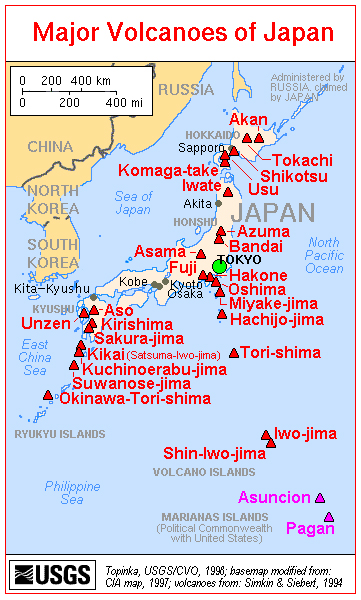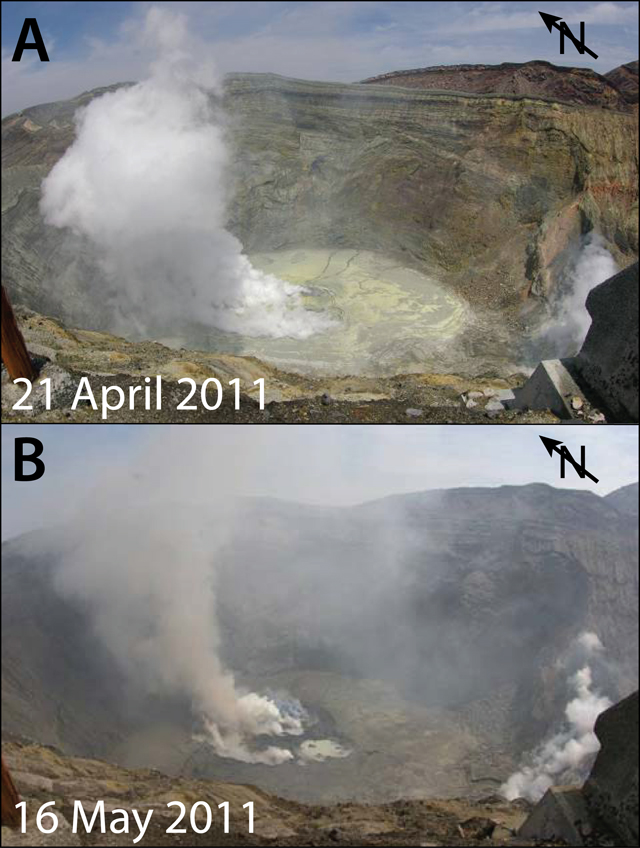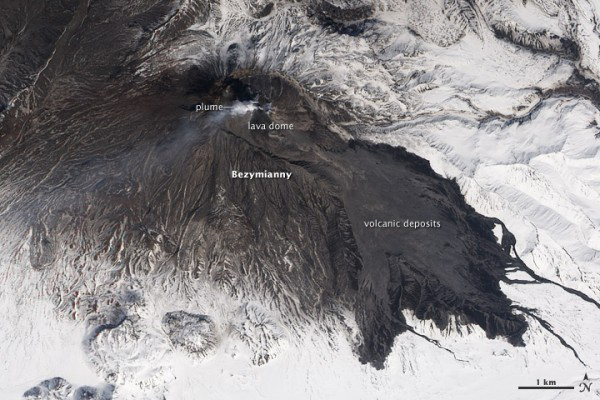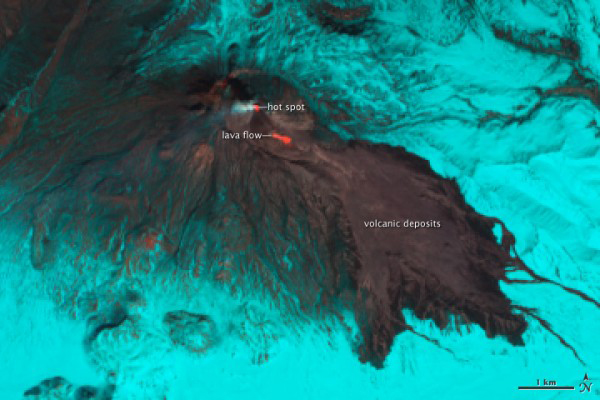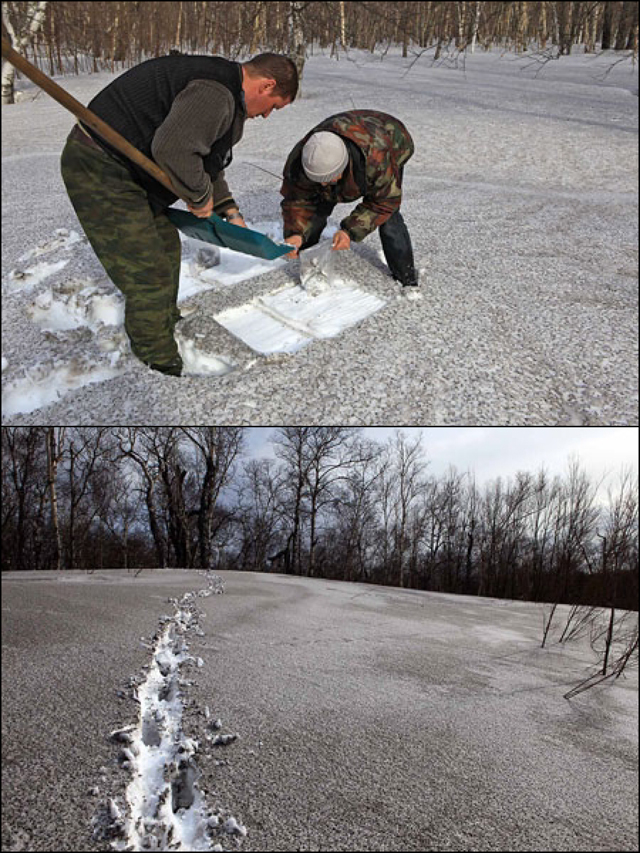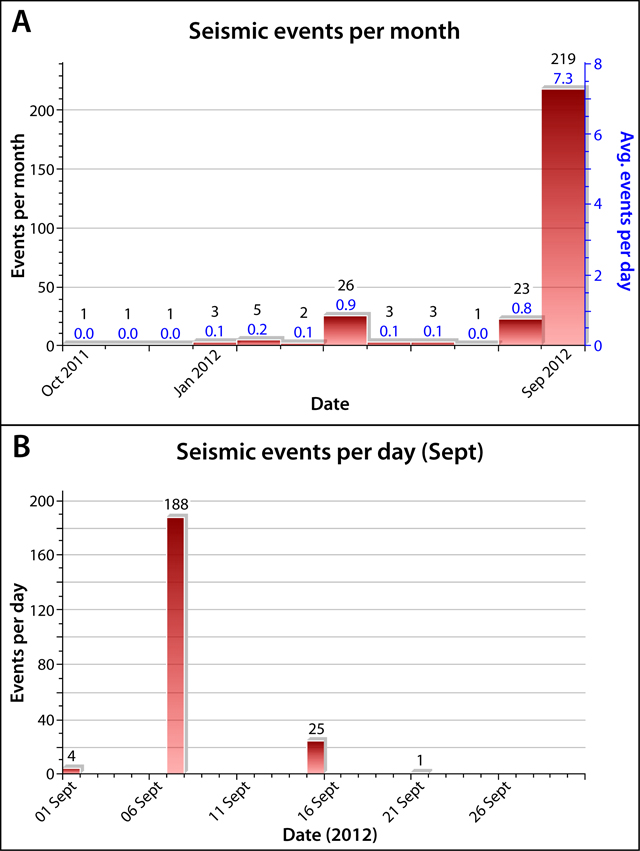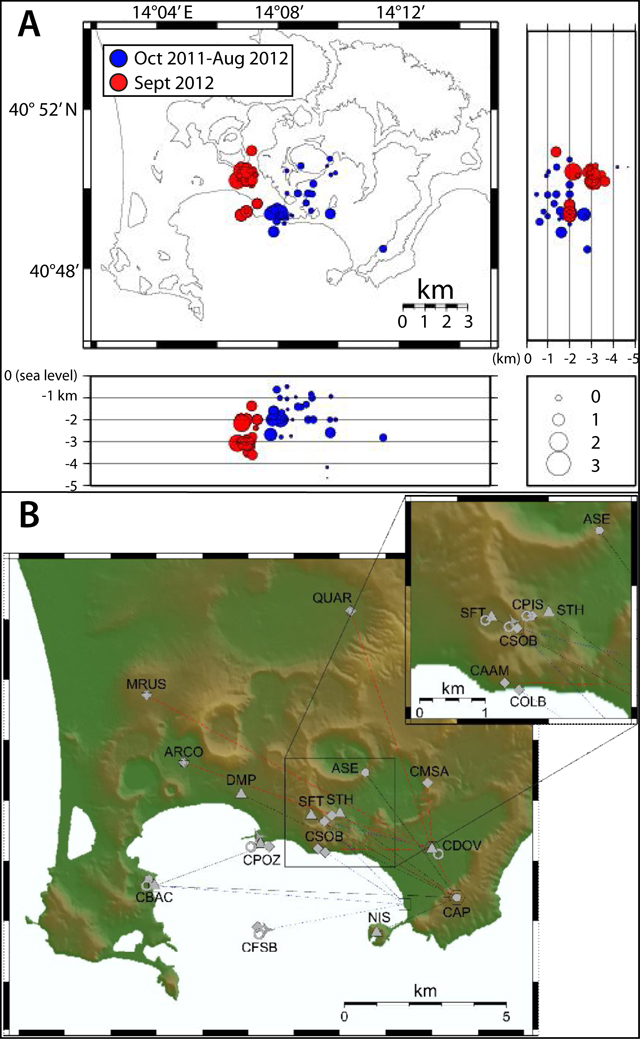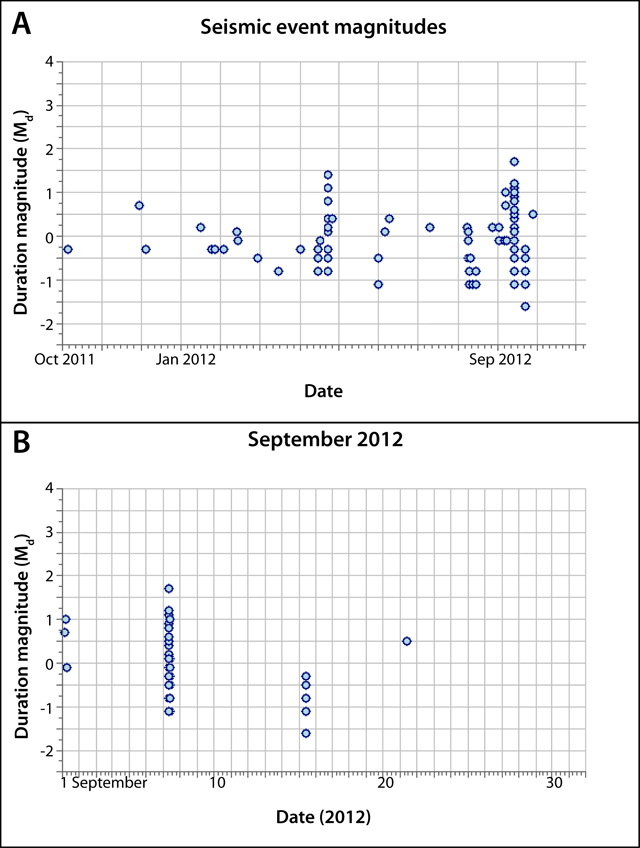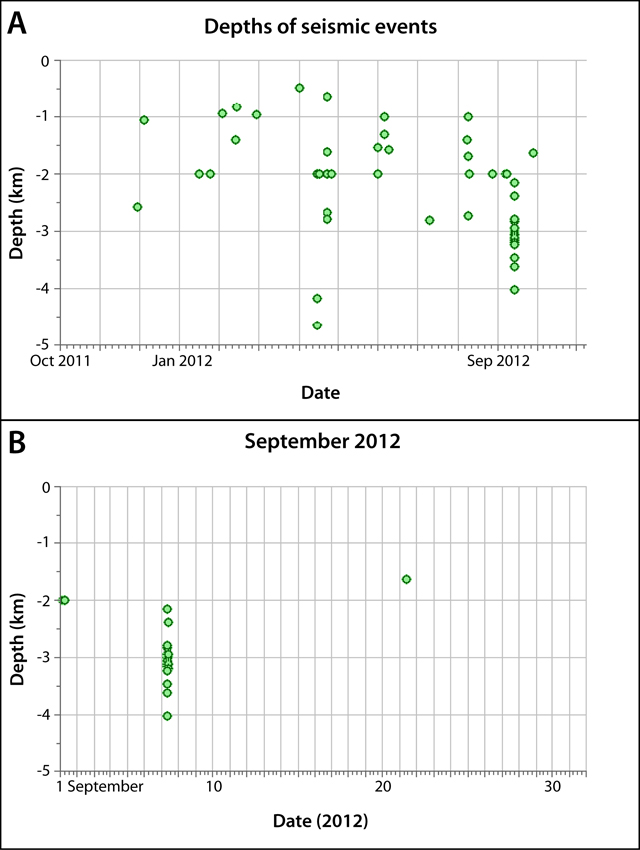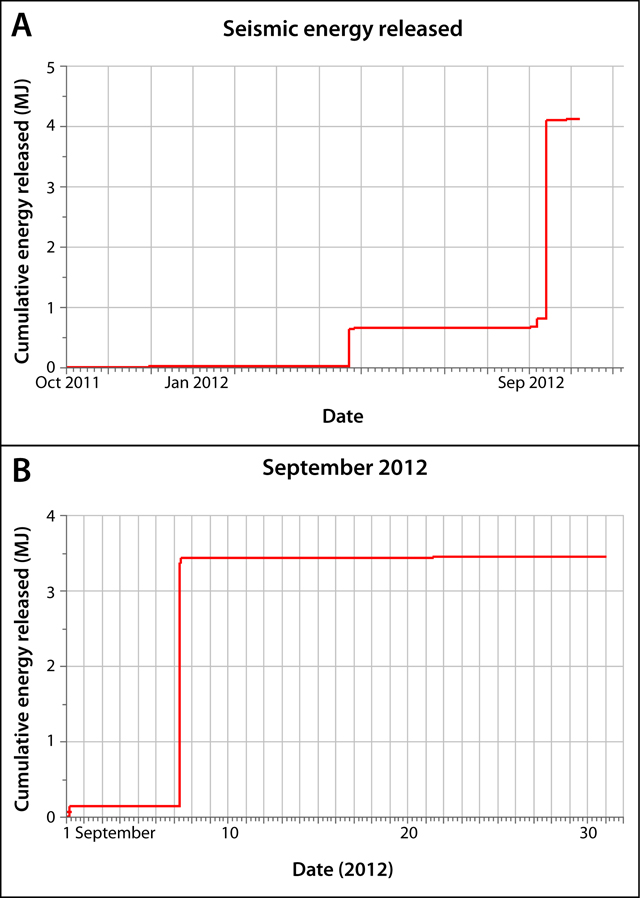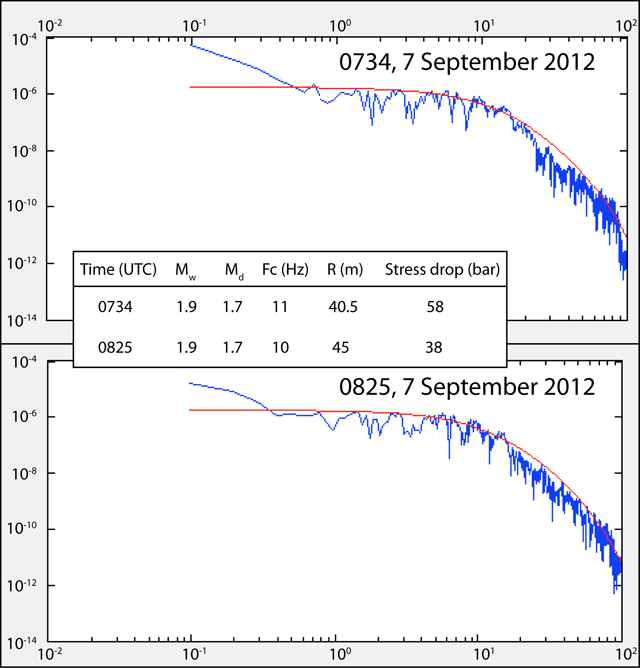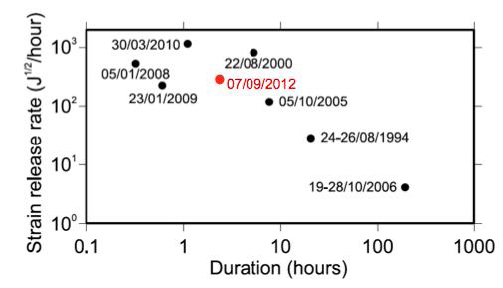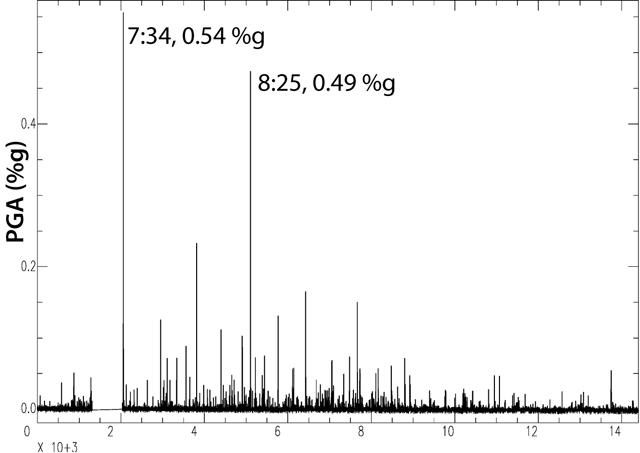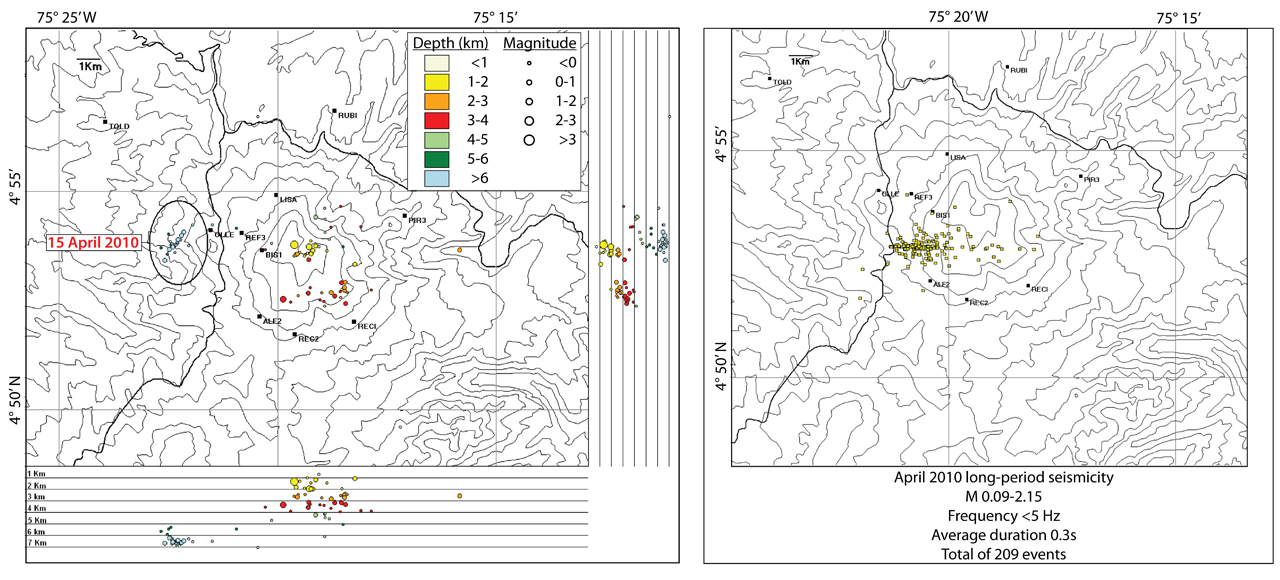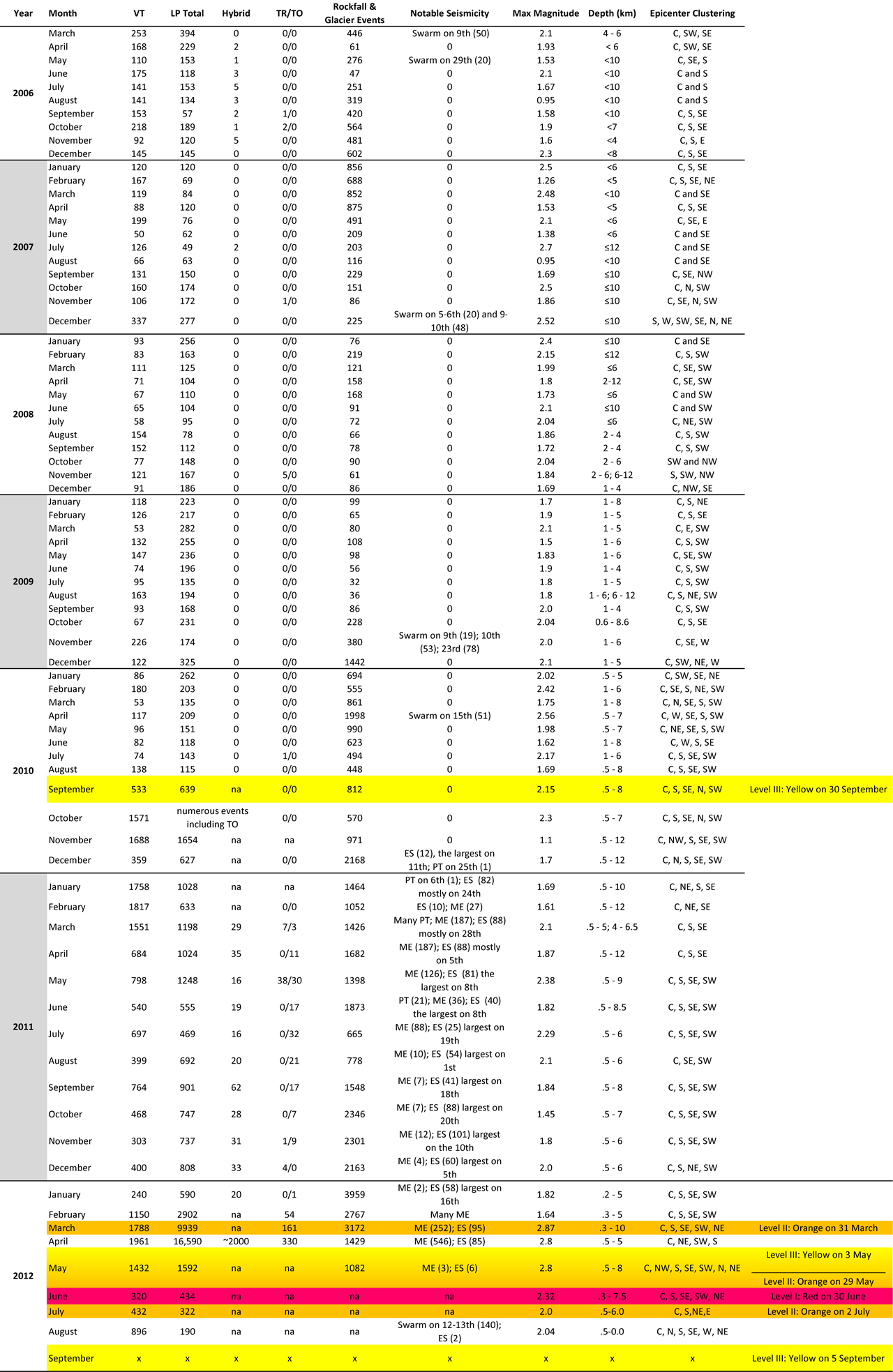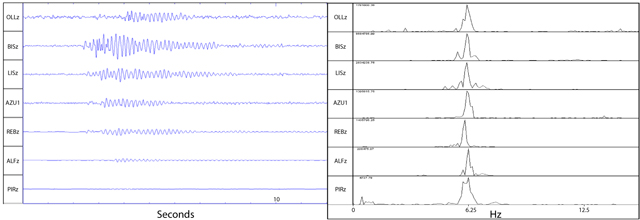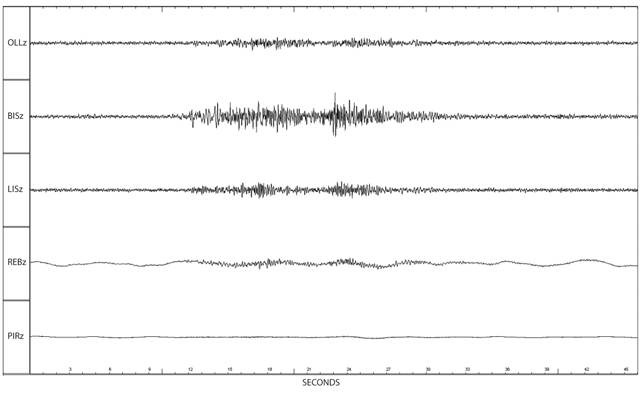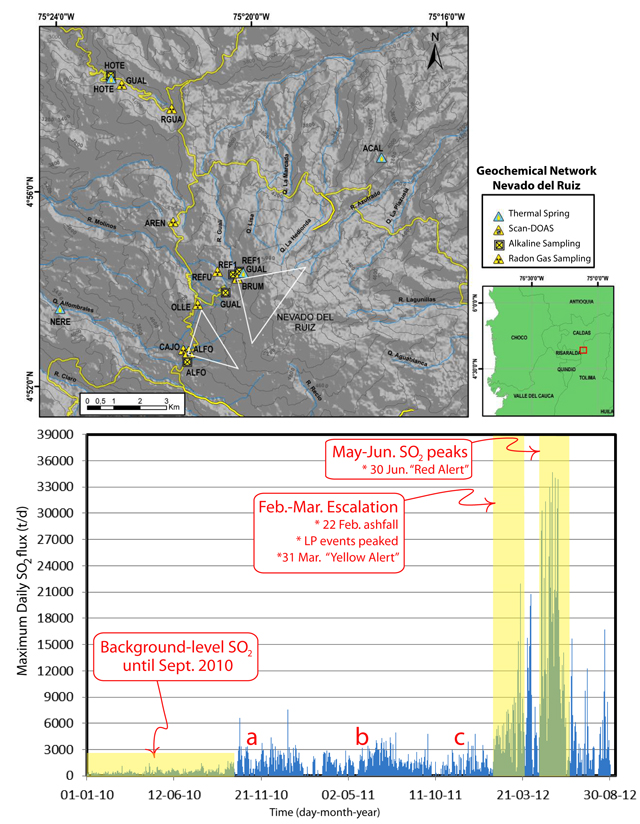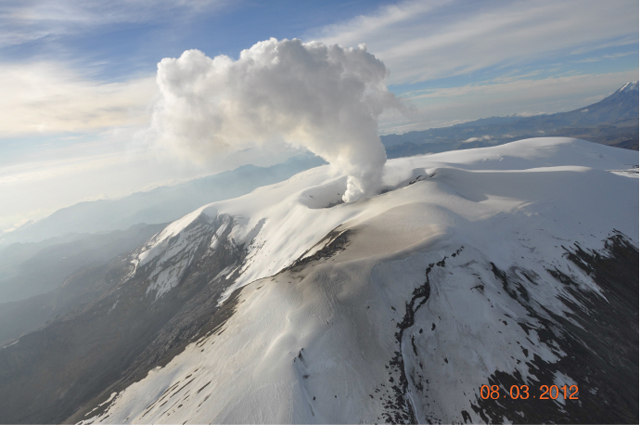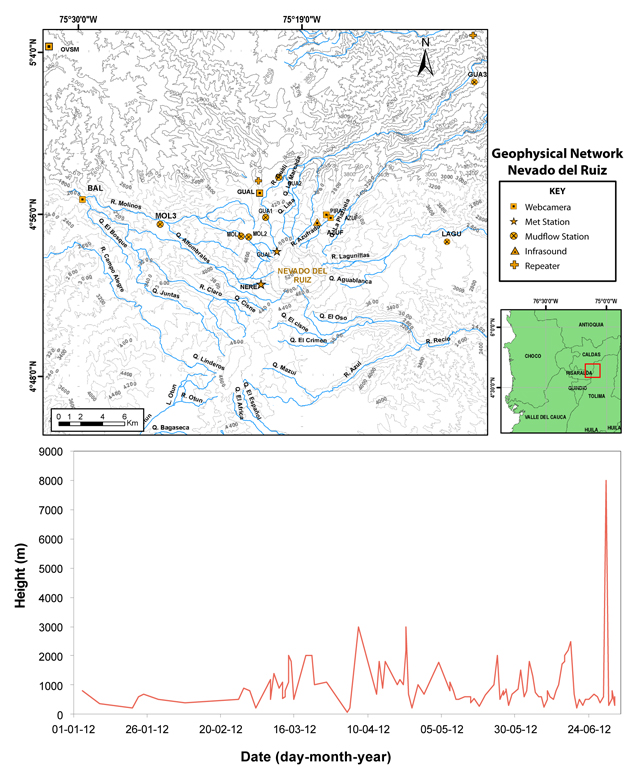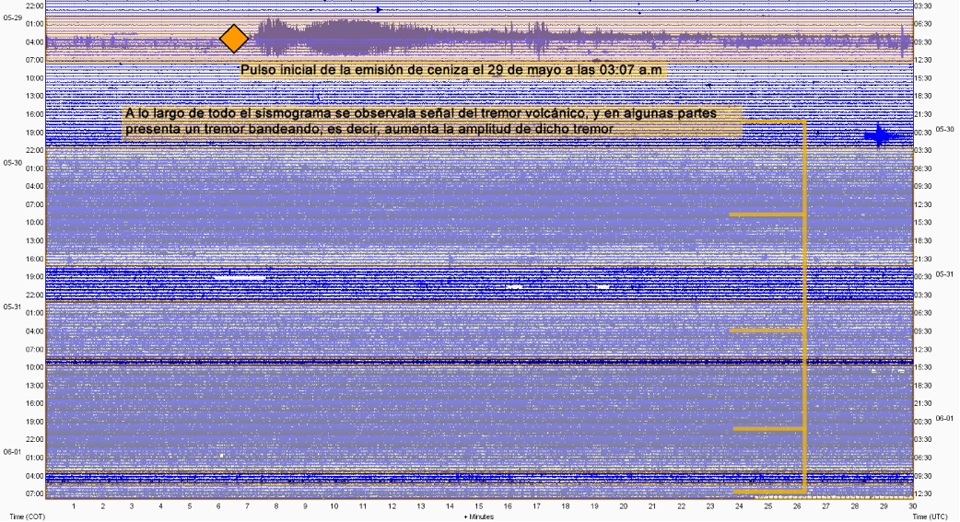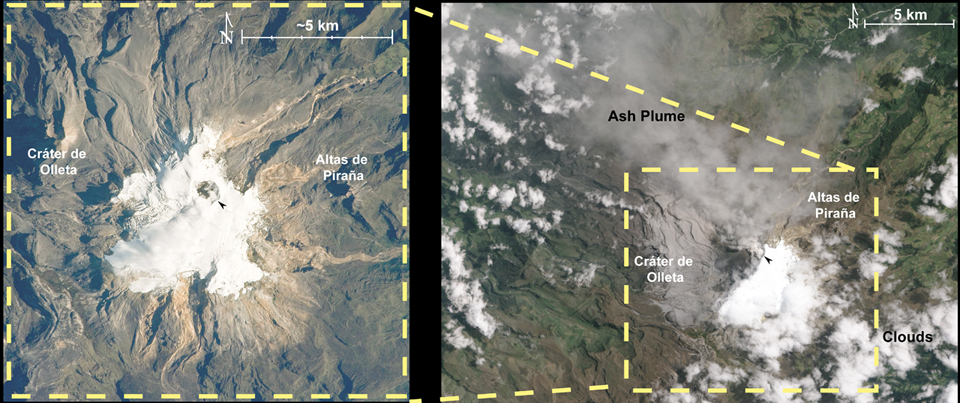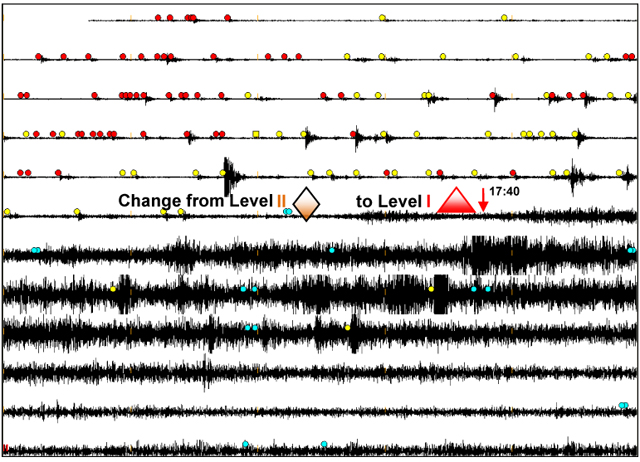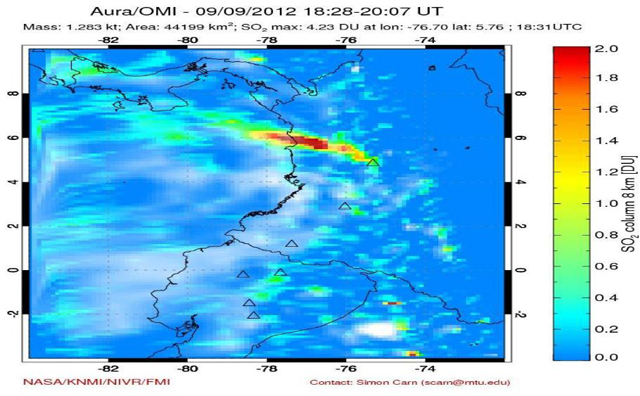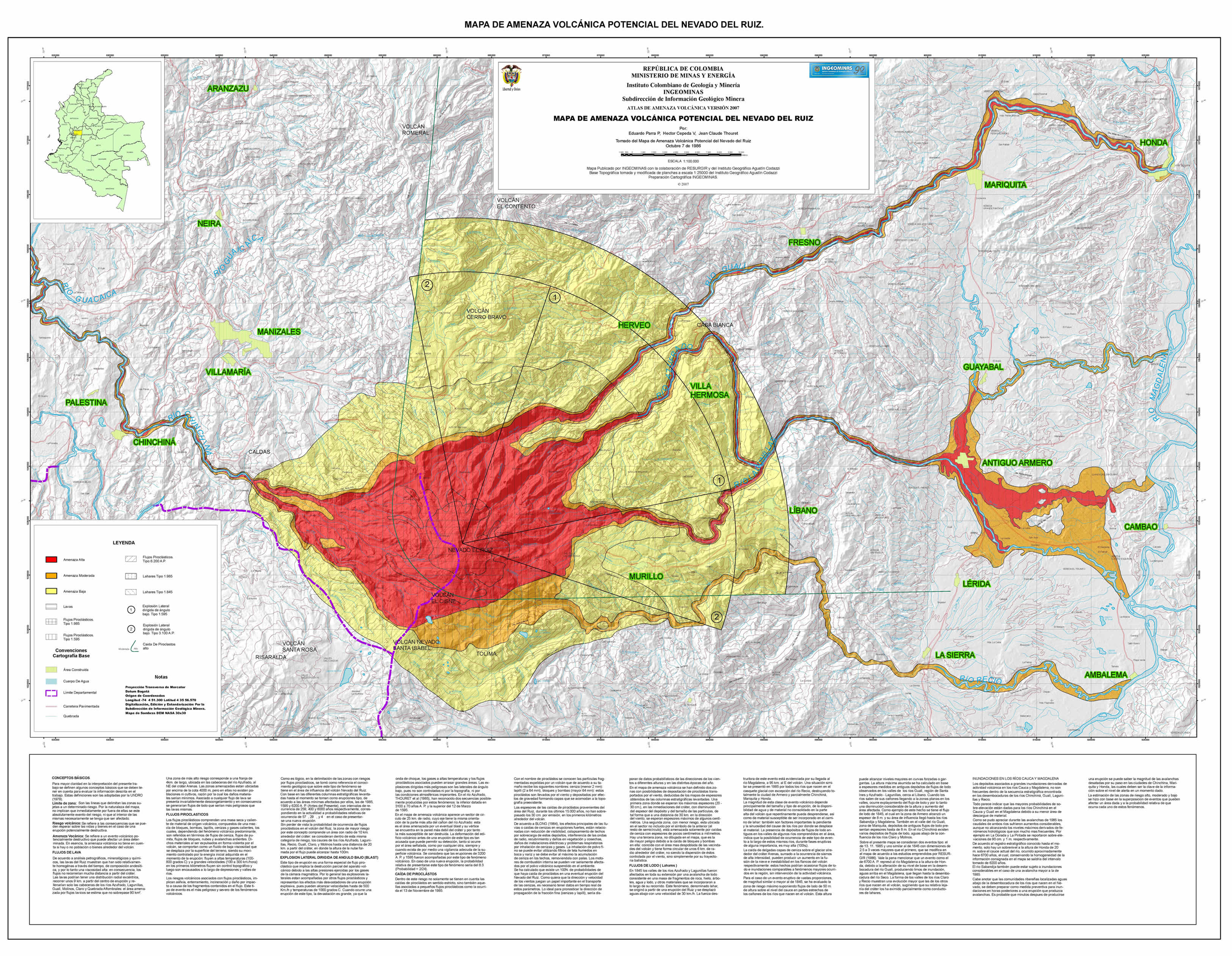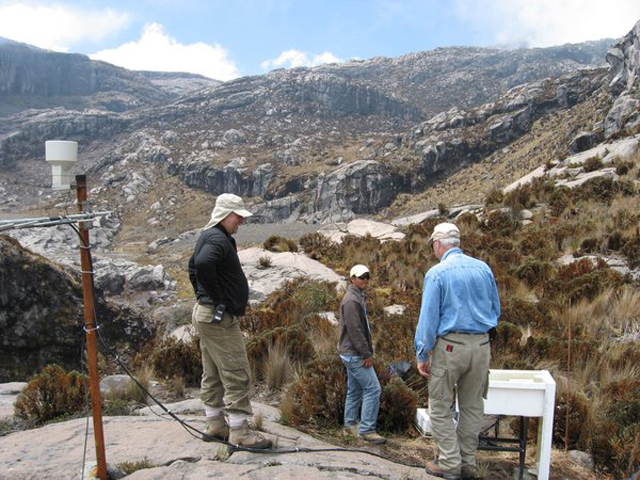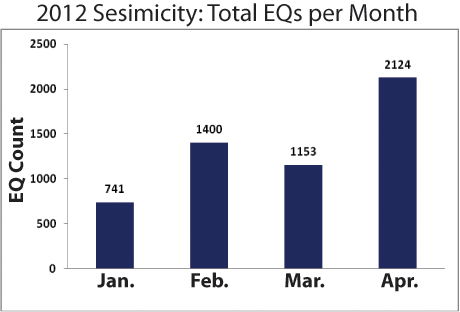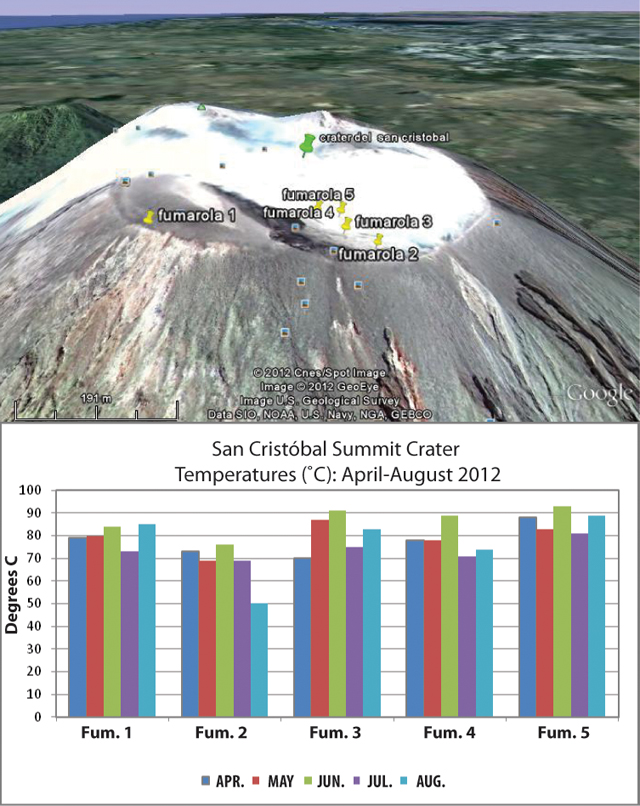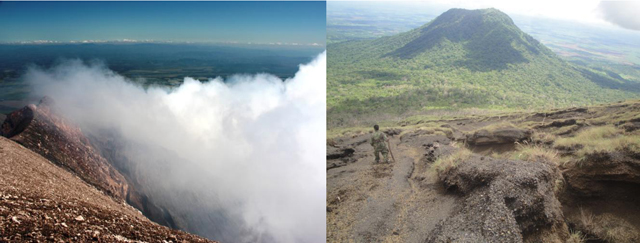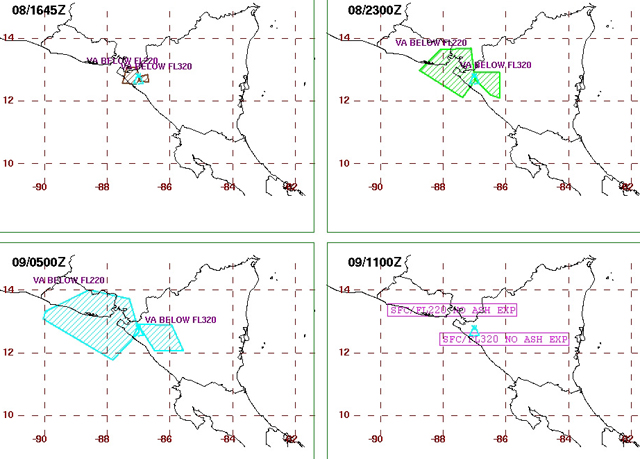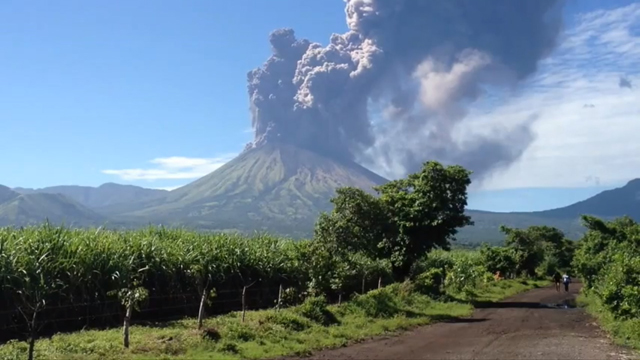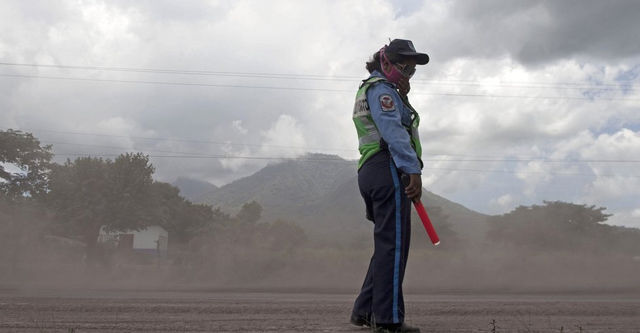Recently Published Bulletin Reports
Erebus (Antarctica) Lava lake remains active; most thermal alerts recorded since 2019
Rincon de la Vieja (Costa Rica) Frequent phreatic explosions during July-December 2023
Bezymianny (Russia) Explosion on 18 October 2023 sends ash plume 8 km high; lava flows and incandescent avalanches
Kilauea (United States) Low-level lava effusions in the lava lake at Halema’uma’u during July-December 2022
Nyamulagira (DR Congo) Lava flows and thermal activity during May-October 2023
Bagana (Papua New Guinea) Explosions, ash plumes, ashfall, and lava flows during April-September 2023
Mayon (Philippines) Lava flows, pyroclastic flows, ash emissions, and seismicity during April-September 2023
Nishinoshima (Japan) Eruption plumes and gas-and-steam plumes during May-August 2023
Krakatau (Indonesia) White gas-and-steam plumes and occasional ash plumes during May-August 2023
Villarrica (Chile) Strombolian activity, gas-and-ash emissions, and crater incandescence during April-September 2023
Merapi (Indonesia) Frequent incandescent avalanches during April-September 2023
Ebeko (Russia) Moderate explosive activity with ash plumes continued during June-November 2023
Erebus (Antarctica) — January 2024  Cite this Report
Cite this Report
Erebus
Antarctica
77.53°S, 167.17°E; summit elev. 3794 m
All times are local (unless otherwise noted)
Lava lake remains active; most thermal alerts recorded since 2019
The lava lake in the summit crater of Erebus has been active since at least 1972. Located in Antarctica overlooking the McMurdo Station on Ross Island, it is the southernmost active volcano on the planet. Because of the remote location, activity is primarily monitored by satellites. This report covers activity during 2023.
The number of thermal alerts recorded by the Hawai'i Institute of Geophysics and Planetology’s MODVOLC Thermal Alerts System increased considerably in 2023 compared to the years 2020-2022 (table 9). In contrast to previous years, the MODIS instruments aboard the Aqua and Terra satellites captured data from Erebus every month during 2023. Consistent with previous years, the lowest number of anomalous pixels were recorded in January, November, and December.
Table 9. Number of monthly MODIS-MODVOLC thermal alert pixels recorded at Erebus during 2017-2023. See BGVN 42:06 for data from 2000 through 2016. The table was compiled using data provided by the HIGP – MODVOLC Thermal Alerts System.
| Year |
Jan |
Feb |
Mar |
Apr |
May |
Jun |
Jul |
Aug |
Sep |
Oct |
Nov |
Dec |
SUM |
| 2017 |
0 |
21 |
9 |
0 |
0 |
1 |
11 |
61 |
76 |
52 |
0 |
3 |
234 |
| 2018 |
0 |
21 |
58 |
182 |
55 |
17 |
137 |
172 |
103 |
29 |
0 |
0 |
774 |
| 2019 |
2 |
21 |
162 |
151 |
55 |
56 |
75 |
53 |
29 |
19 |
1 |
0 |
624 |
| 2020 |
0 |
2 |
16 |
18 |
4 |
4 |
1 |
3 |
18 |
3 |
1 |
6 |
76 |
| 2021 |
0 |
9 |
1 |
0 |
2 |
56 |
46 |
47 |
35 |
52 |
5 |
3 |
256 |
| 2022 |
1 |
13 |
55 |
22 |
15 |
32 |
39 |
19 |
31 |
11 |
0 |
0 |
238 |
| 2023 |
2 |
33 |
49 |
82 |
41 |
32 |
70 |
64 |
42 |
17 |
5 |
11 |
448 |
Sentinel-2 infrared images showed one or two prominent heat sources within the summit crater, accompanied by adjacent smaller sources, similar to recent years (see BGVN 46:01, 47:02, and 48:01). A unique image was obtained on 25 November 2023 by the OLI-2 (Operational Land Imager-2) on Landsat 9, showing the upper part of the volcano surrounded by clouds (figure 32).
Geologic Background. Mount Erebus, the world's southernmost historically active volcano, overlooks the McMurdo research station on Ross Island. It is the largest of three major volcanoes forming the crudely triangular Ross Island. The summit of the dominantly phonolitic volcano has been modified by one or two generations of caldera formation. A summit plateau at about 3,200 m elevation marks the rim of the youngest caldera, which formed during the late-Pleistocene and within which the modern cone was constructed. An elliptical 500 x 600 m wide, 110-m-deep crater truncates the summit and contains an active lava lake within a 250-m-wide, 100-m-deep inner crater; other lava lakes are sometimes present. The glacier-covered volcano was erupting when first sighted by Captain James Ross in 1841. Continuous lava-lake activity with minor explosions, punctuated by occasional larger Strombolian explosions that eject bombs onto the crater rim, has been documented since 1972, but has probably been occurring for much of the volcano's recent history.
Information Contacts: Hawai'i Institute of Geophysics and Planetology (HIGP) - MODVOLC Thermal Alerts System, School of Ocean and Earth Science and Technology (SOEST), Univ. of Hawai'i, 2525 Correa Road, Honolulu, HI 96822, USA (URL: http://modis.higp.hawaii.edu/); Copernicus Browser, Copernicus Data Space Ecosystem, European Space Agency (URL: https://dataspace.copernicus.eu/browser/); NASA Earth Observatory, EOS Project Science Office, NASA Goddard Space Flight Center, Goddard, Maryland, USA (URL: https://earthobservatory.nasa.gov/images/152134/erebus-breaks-through).
Rincon de la Vieja (Costa Rica) — January 2024  Cite this Report
Cite this Report
Rincon de la Vieja
Costa Rica
10.83°N, 85.324°W; summit elev. 1916 m
All times are local (unless otherwise noted)
Frequent phreatic explosions during July-December 2023
Rincón de la Vieja is a volcanic complex in Costa Rica with a hot convecting acid lake that exhibits frequent weak phreatic explosions, gas-and-steam emissions, and occasional elevated sulfur dioxide levels (BGVN 45:10, 46:03, 46:11). The current eruption period began June 2021. This report covers activity during July-December 2023 and is based on weekly bulletins and occasional daily reports from the Observatorio Vulcanologico Sismologica de Costa Rica-Universidad Nacional (OVSICORI-UNA).
Numerous weak phreatic explosions continued during July-December 2023, along with gas-and-steam emissions and plumes that rose as high as 3 km above the crater rim. Many weekly OVSICORI-UNA bulletins included the previous week's number of explosions and emissions (table 9). For many explosions, the time of explosion was given (table 10). Frequent seismic activity (long-period earthquakes, volcano-tectonic earthquakes, and tremor) accompanied the phreatic activity.
Table 9. Number of reported weekly phreatic explosions and gas-and-steam emissions at Rincón de la Vieja, July-December 2023. Counts are reported for the week before the Weekly Bulletin date; not all reports included these data. Courtesy of OVSICORI-UNA.
| OVSICORI Weekly Bulletin |
Number of explosions |
Number of emissions |
| 28 Jul 2023 |
6 |
14 |
| 4 Aug 2023 |
10 |
12 |
| 1 Sep 2023 |
13 |
11 |
| 22 Sep 2023 |
12 |
13 |
| 29 Sep 2023 |
6 |
11 |
| 6 Oct 2023 |
12 |
5 |
| 13 Oct 2023 |
7 |
9 |
| 20 Oct 2023 |
1 |
15 |
| 27 Oct 2023 |
3 |
23 |
| 3 Nov 2023 |
3 |
10 |
| 17 Nov 2023 |
0 |
Some |
| 24 Nov 2023 |
0 |
14 |
| 8 Dec 2023 |
4 |
16 |
| 22 Dec 2023 |
8 |
18 |
Table 10. Summary of activity at Rincón de la Vieja during July-December 2023. Weak phreatic explosions and gas emissions are noted where the time of explosion was indicated in the weekly or daily bulletins. Height of plumes or emissions are distance above the crater rim. Courtesy of OVSICORI-UNA.
| Date |
Time |
Description of Activity |
| 1 Jul 2023 |
0156 |
Explosion. |
| 2 Jul 2023 |
0305 |
Explosion. |
| 4 Jul 2023 |
0229, 0635 |
Event at 0635 produced a gas-and-steam plume that rose 700 m and drifted W; seen by residents in Liberia (21 km SW). |
| 9 Jul 2023 |
1843 |
Explosion. |
| 21 Jul 2023 |
0705 |
Explosion. |
| 26 Jul 2023 |
1807 |
Explosion. |
| 28 Jul 2023 |
0802 |
Explosion generated a gas-and-steam plume that rose 500 m. |
| 30 Jul 2023 |
1250 |
Explosion. |
| 31 Jul 2023 |
2136 |
Explosion. |
| 11 Aug 2023 |
0828 |
Explosion. |
| 18 Aug 2023 |
1304 |
Explosion. |
| 21 Aug 2023 |
1224 |
Explosion generated gas-and-steam plumes rose 500-600 m. |
| 22 Aug 2023 |
0749 |
Explosion generated gas-and-steam plumes rose 500-600 m. |
| 24 Aug 2023 |
1900 |
Explosion. |
| 25 Aug 2023 |
0828 |
Event produced a steam-and-gas plume that rose 3 km and drifted NW. |
| 27-28 Aug 2023 |
0813 |
Four small events; the event at 0813 on 28 August lasted two minutes and generated a steam-and-gas plume that rose 2.5 km. |
| 1 Sep 2023 |
1526 |
Explosion generated plume that rose 2 km and ejected material onto the flanks. |
| 2-3 Sep 2023 |
- |
Small explosions detected in infrasound data. |
| 4 Sep 2023 |
1251 |
Gas-and-steam plume rose 1 km and drifted W. |
| 7 Nov 2023 |
1113 |
Explosion. |
| 8 Nov 2023 |
0722 |
Explosion. |
| 12 Nov 2023 |
0136 |
Small gas emissions. |
| 14 Nov 2023 |
0415 |
Small gas emissions. |
According to OVSICORI-UNA, during July-October the average weekly sulfur dioxide (SO2) flux ranged from 68 to 240 tonnes/day. However, in mid-November the flux increased to as high as 334 tonnes/day, the highest value measured in recent years. The high SO2 flux in mid-November was also detected by the TROPOMI instrument on the Sentinel-5P satellite (figure 43).
Geologic Background. Rincón de la Vieja, the largest volcano in NW Costa Rica, is a remote volcanic complex in the Guanacaste Range. The volcano consists of an elongated, arcuate NW-SE-trending ridge constructed within the 15-km-wide early Pleistocene Guachipelín caldera, whose rim is exposed on the south side. Sometimes known as the "Colossus of Guanacaste," it has an estimated volume of 130 km3 and contains at least nine major eruptive centers. Activity has migrated to the SE, where the youngest-looking craters are located. The twin cone of Santa María volcano, the highest peak of the complex, is located at the eastern end of a smaller, 5-km-wide caldera and has a 500-m-wide crater. A Plinian eruption producing the 0.25 km3 Río Blanca tephra about 3,500 years ago was the last major magmatic eruption. All subsequent eruptions, including numerous historical eruptions possibly dating back to the 16th century, have been from the prominent active crater containing a 500-m-wide acid lake located ENE of Von Seebach crater.
Information Contacts: Observatorio Vulcanológico Sismológica de Costa Rica-Universidad Nacional (OVSICORI-UNA), Apartado 86-3000, Heredia, Costa Rica (URL: http://www.ovsicori.una.ac.cr/); NASA Global Sulfur Dioxide Monitoring Page, Atmospheric Chemistry and Dynamics Laboratory, NASA Goddard Space Flight Center (NASA/GSFC), 8800 Greenbelt Road, Goddard MD 20771, USA (URL: https://so2.gsfc.nasa.gov/).
Bezymianny (Russia) — November 2023  Cite this Report
Cite this Report
Bezymianny
Russia
55.972°N, 160.595°E; summit elev. 2882 m
All times are local (unless otherwise noted)
Explosion on 18 October 2023 sends ash plume 8 km high; lava flows and incandescent avalanches
Bezymianny, located on Russia’s Kamchatka Peninsula, has had eruptions since 1955 characterized by dome growth, explosions, pyroclastic flows, ash plumes, and ashfall. Activity during November 2022-April 2023 included gas-and-steam emissions, lava dome collapses generating avalanches, and persistent thermal activity. Similar eruptive activity continued from May through October 2023, described here based on information from weekly and daily reports of the Kamchatka Volcano Eruptions Response Team (KVERT), notices from Tokyo VAAC (Volcanic Ash Advisory Center), and from satellite data.
Overall activity decreased after the strong period of activity in late March through April 2023, which included ash explosions during 29 March and 7-8 April 2023 that sent plumes as high as 10-12 km altitude, along with dome growth and lava flows (BGVN 48:05). This reduced activity can be seen in the MIROVA thermal detection system graph (figure 56), which was consistent with data from the MODVOLC thermal detection system and with Sentinel-2 satellite images that showed persistent hotspots in the summit crater when conditions allowed observations. A renewed period of strong activity began in mid-October 2023.
Activity increased significantly on 17 October 2023 when large collapses began during 0700-0830 on the E flanks of the lava dome and continued to after 0930 the next day (figure 57). Ash plumes rose to an altitude of 4.5-5 km, extending 220 km NNE by 18 October. A large explosion at 1630 on 18 October produced an ash plume that rose to an altitude of 11 km (8 km above the summit) and drifted NNE and then NW, extending 900 km NW within two days at an altitude of 8 km. Minor ashfall was noted in Kozyrevsk (45 km WNW). At 0820 on 20 October an ash plume was identified in satellite images drifting 100 km ENE at altitudes of 4-4.5 km.
Lava flows and hot avalanches from the dome down the SE flank continued over the next few days, including 23 October when clear conditions allowed good observations (figures 58 and 59). A large thermal anomaly was observed over the volcano through 24 October, and in the summit crater on 30 October (figure 60). Strong fumarolic activity continued, with numerous avalanches and occasional incandescence. By the last week of October, volcanic activity had decreased to a level consistent with that earlier in the reporting period.
Aviation warnings were frequently updated during 17-20 October. KVERT issued a Volcano Observatory Notice for Aviation (VONA) on 17 October at 1419 and 1727 (0219 and 0527 UTC) raising the Aviation Color Code (ACC) from Yellow to Orange (second highest level). The next day, KVERT issued a VONA at 1705 (0505 UTC) raising the ACC to Red (highest level) but lowered it back to Orange at 2117 (0917 UTC). After another decrease to Yellow and back to Orange, the ACC was reduced to Yellow on 20 October at 1204 (0004 UTC). In addition, the Tokyo VAAC issued a series of Volcanic Ash Advisories beginning on 16 October and continuing through 30 October.
Geologic Background. The modern Bezymianny, much smaller than its massive neighbors Kamen and Kliuchevskoi on the Kamchatka Peninsula, was formed about 4,700 years ago over a late-Pleistocene lava-dome complex and an edifice built about 11,000-7,000 years ago. Three periods of intensified activity have occurred during the past 3,000 years. The latest period, which was preceded by a 1,000-year quiescence, began with the dramatic 1955-56 eruption. This eruption, similar to that of St. Helens in 1980, produced a large open crater that was formed by collapse of the summit and an associated lateral blast. Subsequent episodic but ongoing lava-dome growth, accompanied by intermittent explosive activity and pyroclastic flows, has largely filled the 1956 crater.
Information Contacts: Kamchatka Volcanic Eruptions Response Team (KVERT), Far Eastern Branch, Russian Academy of Sciences, 9 Piip Blvd., Petropavlovsk-Kamchatsky, 683006, Russia (URL: http://www.kscnet.ru/ivs/kvert/); Kamchatka Volcanological Station, Kamchatka Branch of Geophysical Survey, (KB GS RAS), Klyuchi, Kamchatka Krai, Russia (URL: http://volkstat.ru/); Tokyo Volcanic Ash Advisory Center (VAAC), 1-3-4 Otemachi, Chiyoda-ku, Tokyo 100-8122, Japan (URL: http://ds.data.jma.go.jp/svd/vaac/data/); Hawai'i Institute of Geophysics and Planetology (HIGP) - MODVOLC Thermal Alerts System, School of Ocean and Earth Science and Technology (SOEST), Univ. of Hawai'i, 2525 Correa Road, Honolulu, HI 96822, USA (URL: http://modis.higp.hawaii.edu/); MIROVA (Middle InfraRed Observation of Volcanic Activity), a collaborative project between the Universities of Turin and Florence (Italy) supported by the Centre for Volcanic Risk of the Italian Civil Protection Department (URL: http://www.mirovaweb.it/); Copernicus Browser, Copernicus Data Space Ecosystem, European Space Agency (URL: https://dataspace.copernicus.eu/browser/).chr
Kilauea (United States) — January 2023  Cite this Report
Cite this Report
Kilauea
United States
19.421°N, 155.287°W; summit elev. 1222 m
All times are local (unless otherwise noted)
Low-level lava effusions in the lava lake at Halema’uma’u during July-December 2022
Kīlauea is the southeastern-most volcano in Hawaii and overlaps the E flank of the Mauna Loa volcano. Its East Rift Zone (ERZ) has been intermittently active for at least 2,000 years. An extended eruption period began in January 1983 and was characterized by open lava lakes and lava flows from the summit caldera and the East Rift Zone. During May 2018 magma migrated into the Lower East Rift Zone (LERZ) and opened 24 fissures along a 6-km-long NE-trending fracture zone that produced lava flows traveling in multiple directions. As lava emerged from the fissures, the lava lake at Halema'uma'u drained and explosions sent ash plumes to several kilometers altitude (BGVN 43:10).
The current eruption period started during September 2021 and has recently been characterized by lava effusions, spatter, and sulfur dioxide emissions in the active Halema’uma’u lava lake (BGVN 47:08). Lava effusions, some spatter, and sulfur dioxide emissions have continued during this reporting period of July through December 2022 using daily reports, volcanic activity notices, and abundant photo, map, and video data from the US Geological Survey's (USGS) Hawaiian Volcano Observatory (HVO).
Summary of activity during July-December 2022. Low-level effusions have continued at the western vent of the Halema’uma’u crater during July through early December 2022. Occasional weak ooze-outs (also called lava break outs) would occur along the margins of the crater floor. The overall level of the active lava lake throughout the reporting period gradually increased due to infilling, however it stagnated in mid-September (table 13). During September through November, activity began to decline, though lava effusions persisted at the western vent. By 9 December, the active part of the lava lake had completely crusted over, and incandescence was no longer visible.
Table 13. Summary of measurements taken during overflights at Kīlauea that show a gradual increase in the active lava lake level and the volume of lava effused since 29 September 2021. Lower activity was reported during September-October. Data collected during July-December 2022. Courtesy of HVO.
| Date: |
Level of the active lava lake (m): |
Cumulative volume of lava effused (million cubic meters): |
| 7 Jul 2022 |
130 |
95 |
| 19 Jul 2022 |
133 |
98 |
| 4 Aug 2022 |
136 |
102 |
| 16 Aug 2022 |
137 |
104 |
| 12 Sep 2022 |
143 |
111 |
| 5 Oct 2022 |
143 |
111 |
| 28 Oct 2022 |
143 |
111 |
Activity during July 2022. Lava effusions were reported from the western vent in the Halema’uma’u crater, along with occasional weak ooze-outs along the margins of the crater floor. The height of the lava lake was variable due to deflation-inflation tilt events; for example, the lake level dropped approximately 3-4 m during a summit deflation-inflation event reported on 1 July. Webcam images taken during the night of 6-12 July showed intermittent low-level spattering at the western vent that rose less than 10 m above the vent (figure 519). Measurements made during an overflight on 7 July indicated that the crater floor was infilled about 130 m and that 95 million cubic meters of lava had been effused since 29 September 2021. A single, relatively small lava ooze-out was active to the S of the lava lake. Around midnight on 8 July there were two brief periods of lava overflow onto the lake margins. On 9 July lava ooze-outs were reported near the SE and NE edges of the crater floor and during 10-11 July they occurred near the E, NE, and NW edges. On 16 July crater incandescence was reported, though the ooze-outs and spattering were not visible. On 18 July overnight webcam images showed incandescence in the western vent complex and two ooze-outs were reported around 0000 and 0200 on 19 July. By 0900 there were active ooze-outs along the SW edge of the crater floor. Measurements made from an overflight on 19 July indicated that the crater floor was infilled about 133 m and 98 million cubic meters of lava had erupted since 29 September 2021 (figure 520). On 20 July around 1600 active ooze-outs were visible along the N edge of the crater, which continued through the next day. Extensive ooze-outs occurred along the W margin during 24 July until 1900; on 26 July minor ooze-outs were noted along the N margin. Minor spattering was visible on 29 July along the E margin of the lake. The sulfur dioxide emission rates ranged 650-2,800 tons per day (t/d), the higher of which was measured on 8 July (figure 519).
Activity during August 2022. The eruption continued in the Halema’uma’u crater at the western vent. According to HVO the lava in the active lake remained at the level of the bounding levees. Occasional minor ooze-outs were observed along the margins of the crater floor. Strong nighttime crater incandescence was visible after midnight on 6 August over the western vent cone. During 6-7 August scattered small lava lobes were active along the crater floor and incandescence persisted above the western vent through 9 August. During 7-9 August HVO reported a single lava effusion source was active along the NW margin of the crater floor. Measurements from an overflight on 4 August indicated that the crater floor was infilled about 136 m total and that 102 million cubic meters of lava had been erupted since the start of the eruption. Lava breakouts were reported along the N, NE, E, S, and W margins of the crater during 10-16 August. Another overflight survey conducted on 16 August indicated that the crater floor infilled about 137 m and 104 million cubic meters of lava had been erupted since September 2021. Measured sulfur dioxide emissions rates ranged 1,150-2,450 t/d, the higher of which occurred on 8 August.
Activity during September 2022. During September, lava effusion continued from the western vent into the active lava lake and onto the crater floor. Intermittent minor ooze-outs were reported through the month. A small ooze-out was visible on the W crater floor margin at 0220 on 2 September, which showed decreasing surface activity throughout the day, but remained active through 3 September. On 3 September around 1900 a lava outbreak occurred along the NW margin of the crater floor but had stopped by the evening of 4 September. Field crews monitoring the summit lava lake on 9 September observed spattering on the NE margin of the lake that rose no higher than 10 m, before falling back onto the lava lake crust (figure 521). Overflight measurements on 12 September indicated that the crater floor was infilled a total of 143 m and 111 million cubic meters of lava had been erupted since September 2021. Extensive breakouts in the W and N part of the crater floor were reported at 1600 on 20 September and continued into 26 September. The active part of the lava lake dropped by 10 m while other parts of the crater floor dropped by several meters. Summit tiltmeters recorded a summit seismic swarm of more than 80 earthquakes during 1500-1800 on 21 September, which occurred about 1.5 km below Halema’uma’u; a majority of these were less than Mw 2. By 22 September the active part of the lava lake was infilled about 2 m. On 23 September the western vent areas exhibited several small spatter cones with incandescent openings, along with weak, sporadic spattering (figure 522). The sulfur dioxide emission rate ranged from 930 t/d to 2,000 t/d, the higher of which was measured on 6 September.
Activity during October 2022. Activity during October declined slightly compared to previous months, though lava effusions persisted from the western vent into the active lava lake and onto the crater floor during October (figure 523). Slight variations in the lava lake were noted throughout the month. HVO reported that around 0600 on 3 October the level of the lava lake has lowered slightly. Overflight measurements taken on 5 October indicated that the crater floor was infilled a total of about 143 m and that 111 million cubic meters of lava had been effused since September 2021. During 6-7 October the lake gradually rose 0.5 m. Sulfur dioxide measurements made on 22 October had an emission rate of 700 t/d. Another overflight taken on 28 October showed that there was little to no change in the elevation of the crater floor: the crater floor was infilled a total of 143 m and 111 million cubic meters of lava had erupted since the start of the eruption.
Activity during November 2022. Activity remained low during November, though HVO reported that lava from the western vent continued to effuse into the active lava lake and onto the crater floor throughout the month. The rate of sulfur dioxide emissions during November ranged from 300-600 t/d, the higher amount of which occurred on 9 November.
Activity during December 2022. Similar low activity was reported during December, with lava effusing from the western vent into the active lava lake and onto the crater floor. During 4-5 December the active part of the lava lake was slightly variable in elevation and fluctuated within 1 m. On 9 December HVO reported that lava was no longer erupting from the western vent in the Halema’uma’u crater and that sulfur dioxide emissions had returned to near pre-eruption background levels; during 10-11 December, the lava lake had completely crusted over, and no incandescence was visible (figure 524). Time lapse camera images covering the 4-10 December showed that the crater floor showed weak deflation and no inflation. Some passive events of crustal overturning were reported during 14-15 December, which brought fresh incandescent lava to the lake surface. The sulfur dioxide emission rate was approximately 200 t/d on 14 December. A smaller overturn event on 17 December and another that occurred around 0000 and into the morning of 20 December were also detected. A small seismic swarm was later detected on 30 December.
Geologic Background. Kilauea overlaps the E flank of the massive Mauna Loa shield volcano in the island of Hawaii. Eruptions are prominent in Polynesian legends; written documentation since 1820 records frequent summit and flank lava flow eruptions interspersed with periods of long-term lava lake activity at Halemaumau crater in the summit caldera until 1924. The 3 x 5 km caldera was formed in several stages about 1,500 years ago and during the 18th century; eruptions have also originated from the lengthy East and Southwest rift zones, which extend to the ocean in both directions. About 90% of the surface of the basaltic shield volcano is formed of lava flows less than about 1,100 years old; 70% of the surface is younger than 600 years. The long-term eruption from the East rift zone between 1983 and 2018 produced lava flows covering more than 100 km2, destroyed hundreds of houses, and added new coastline.
Information Contacts: Hawaiian Volcano Observatory (HVO), U.S. Geological Survey, PO Box 51, Hawai'i National Park, HI 96718, USA (URL: http://hvo.wr.usgs.gov/).
Nyamulagira (DR Congo) — November 2023  Cite this Report
Cite this Report
Nyamulagira
DR Congo
1.408°S, 29.2°E; summit elev. 3058 m
All times are local (unless otherwise noted)
Lava flows and thermal activity during May-October 2023
Nyamulagira (also known as Nyamuragira) is a shield volcano in the Democratic Republic of Congo with the summit truncated by a small 2 x 2.3 km caldera with walls up to about 100 m high. Documented eruptions have occurred within the summit caldera, as well as from numerous flank fissures and cinder cones. The current eruption period began in April 2018 and has more recently been characterized by summit crater lava flows and thermal activity (BGVN 48:05). This report describes lava flows and variable thermal activity during May through October 2023, based on information from the Observatoire Volcanologique de Goma (OVG) and various satellite data.
Lava lake activity continued during May. The MIROVA (Middle InfraRed Observation of Volcanic Activity) system recorded moderate-to-strong thermal activity throughout the reporting period; activity was more intense during May and October and relatively weaker from June through September (figure 95). The MODVOLC thermal algorithm, detected a total of 209 thermal alerts. There were 143 hotspots detected during May, eight during June, nine during September, and 49 during October. This activity was also reflected in infrared satellite images, where a lava flow was visible in the NW part of the crater on 7 May and strong activity was seen in the center of the crater on 4 October (figure 96). Another infrared satellite image taken on 12 May showed still active lava flows along the NW margin of the crater. According to OVG lava effusions were active during 7-29 May and moved to the N and NW parts of the crater beginning on 9 May. Strong summit crater incandescence was visible from Goma (27 km S) during the nights of 17, 19, and 20 May (figure 97). On 17 May there was an increase in eruptive activity, which peaked at 0100 on 20 May. Notable sulfur dioxide plumes drifted NW and W during 19-20 May (figure 98). Drone footage acquired in partnership with the USGS (United States Geological Survey) on 20 May captured images of narrow lava flows that traveled about 100 m down the W flank (figure 99). Data from the Rumangabo seismic station indicated a decreasing trend in activity during 17-21 May. Although weather clouds prevented clear views of the summit, a strong thermal signature on the NW flank was visible in an infrared satellite image on 22 May, based on an infrared satellite image. On 28 May the lava flows on the upper W flank began to cool and solidify. By 29 May seismicity returned to levels similar to those recorded before the 17 May increase. Lava effusion continued but was confined to the summit crater; periodic crater incandescence was observed.
Low-level activity was noted during June through October. On 1 June OVG reported that seismicity remained at lower levels and that crater incandescence had been absent for three days, though infrared satellite imagery showed continued lava effusion in the summit crater. The lava flows on the flanks covered an estimated 0.6 km2. Satellite imagery continued to show thermal activity confined to the lava lake through October (figure 96), although no lava flows or significant sulfur dioxide emissions were reported.
Geologic Background. Africa's most active volcano, Nyamulagira (also known as Nyamuragira), is a massive high-potassium basaltic shield about 25 km N of Lake Kivu and 13 km NNW of the steep-sided Nyiragongo volcano. The summit is truncated by a small 2 x 2.3 km caldera that has walls up to about 100 m high. Documented eruptions have occurred within the summit caldera, as well as from the numerous flank fissures and cinder cones. A lava lake in the summit crater, active since at least 1921, drained in 1938, at the time of a major flank eruption. Recent lava flows extend down the flanks more than 30 km from the summit as far as Lake Kivu; extensive lava flows from this volcano have covered 1,500 km2 of the western branch of the East African Rift.
Information Contacts: Observatoire Volcanologique de Goma (OVG), Departement de Geophysique, Centre de Recherche en Sciences Naturelles, Lwiro, D.S. Bukavu, DR Congo; Hawai'i Institute of Geophysics and Planetology (HIGP) - MODVOLC Thermal Alerts System, School of Ocean and Earth Science and Technology (SOEST), Univ. of Hawai'i, 2525 Correa Road, Honolulu, HI 96822, USA (URL: http://modis.higp.hawaii.edu/); MIROVA (Middle InfraRed Observation of Volcanic Activity), a collaborative project between the Universities of Turin and Florence (Italy) supported by the Centre for Volcanic Risk of the Italian Civil Protection Department (URL: http://www.mirovaweb.it/); NASA Global Sulfur Dioxide Monitoring Page, Atmospheric Chemistry and Dynamics Laboratory, NASA Goddard Space Flight Center (NASA/GSFC), 8800 Greenbelt Road, Goddard, Maryland, USA (URL: https://so2.gsfc.nasa.gov/); Copernicus Browser, Copernicus Data Space Ecosystem, European Space Agency (URL: https://dataspace.copernicus.eu/browser/); Charles Balagizi, Goma Volcano Observatory, Departement de Geophysique, Centre de Recherche en Sciences Naturelles, Lwiro, D.S. Bukavu, DR Congo.
Bagana (Papua New Guinea) — October 2023  Cite this Report
Cite this Report
Bagana
Papua New Guinea
6.137°S, 155.196°E; summit elev. 1855 m
All times are local (unless otherwise noted)
Explosions, ash plumes, ashfall, and lava flows during April-September 2023
The remote volcano of Bagana is located in central Bougainville Island, Papua New Guinea. Recorded eruptions date back to 1842 and activity has consisted of effusive activity that has built a small lava dome in the summit crater and occasional explosions that produced pyroclastic flows. The most recent eruption has been ongoing since February 2000 and has produced occasional explosions, ash plumes, and lava flows. More recently, activity has been characterized by ongoing effusive activity and ash emissions (BGVN 48:04). This report updates activity from April through September 2023 that has consisted of explosions, ash plumes, ashfall, and lava flows, using information from the Darwin Volcanic Ash Advisory Center (VAAC) and satellite data.
An explosive eruption was reported on 7 July that generated a large gas-and-ash plume to high altitudes and caused significant ashfall in local communities; the eruption plume had reached upper tropospheric (16-18 km altitude) altitudes by 2200, according to satellite images. Sulfur dioxide plumes were detected in satellite images on 8 July and indicated that the plume was likely a mixture of gas, ice, and ash. A report issued by the Autonomous Bougainville Government (ABG) (Torokina District, Education Section) on 10 July noted that significant ash began falling during 2000-2100 on 7 July and covered most areas in the Vuakovi, Gotana (9 km SW), Koromaketo, Laruma (25 km W) and Atsilima (27 km NW) villages. Pyroclastic flows also occurred, according to ground-based reports; small deposits confined to one drainage were inspected by RVO during an overflight on 17 July and were confirmed to be from the 7 July event. Ashfall continued until 10 July and covered vegetation, which destroyed bushes and gardens and contaminated rivers and streams.
RVO reported another eruption on 14 July. The Darwin VAAC stated that an explosive event started around 0830 on 15 July and produced an ash plume that rose to 16.5 km altitude by 1000 and drifted N, according to satellite images. The plume continued to drift N and remained visible through 1900, and by 2150 it had dissipated.
Ashfall likely from both the 7 and 15 July events impacted about 8,111 people in Torokina (20 km SW), including Tsito/Vuakovi, Gotana, Koromaketo, Kenaia, Longkogari, Kenbaki, Piva (13 km SW), and Atsinima, and in the Tsitovi district, according to ABG. Significant ashfall was also reported in Ruruvu (22 km N) in the Wakunai District of Central Bougainville, though the thickness of these deposits could not be confirmed. An evacuation was called for the villages in Wakunai, where heavy ashfall had contaminated water sources; the communities of Ruruvu, Togarau, Kakarapaia, Karauturi, Atao, and Kuritaturi were asked to evacuate to a disaster center at the Wakunai District Station, and communities in Torokina were asked to evacuate to the Piva District station. According to a news article, more than 7,000 people needed temporary accommodations, with about 1,000 people in evacuation shelters. Ashfall had deposited over a broad area, contaminating water supplies, affecting crops, and collapsing some roofs and houses in rural areas. Schools were temporarily shut down. Intermittent ash emissions continued through the end of July and drifted NNW, NW, and SW. Fine ashfall was reported on the coast of Torokina, and ash plumes also drifted toward Laruma and Atsilima.
A small explosive eruption occurred at 2130 on 28 July that ejected material from the crater vents, according to reports from Torokina, in addition to a lava flow that contained two lobes. A second explosion was detected at 2157. Incandescence from the lava flow was visible from Piva as it descended the W flank around 2000 on 29 July (figure 47). The Darwin VAAC reported that a strong thermal anomaly was visible in satellite images during 30-31 July and that ash emissions rose to 2.4 km altitude and drifted WSW on 30 July. A ground report from RVO described localized emissions at 0900 on 31 July.
The Darwin VAAC reported that ash plumes were identified in satellite imagery at 0800 and 1220 on 12 August and rose to 2.1 km and 3 km altitude and drifted NW and W, respectively. A news report stated that aid was sent to more than 6,300 people that were adversely affected by the eruption. Photos taken during 17-19 August showed ash emissions rising no higher than 1 km above the summit and drifting SE. A small explosion generated an ash plume during the morning of 19 August. Deposits from small pyroclastic flows were also captured in the photos. Satellite images captured lava flows and pyroclastic flow deposits. Two temporary seismic stations were installed near Bagana on 17 August at distances of 7 km WSW (Vakovi station) and 11 km SW (Kepox station). The Kepox station immediately started to record continuous, low-frequency background seismicity.
Satellite data. Little to no thermal activity was detected during April through mid-July 2023; only one anomaly was recorded during early April and one during early June, according to MIROVA (Middle InfraRed Observation of Volcanic Activity) data (figure 48). Thermal activity increased in both power and frequency during mid-July through September, although there were still some short gaps in detected activity. MODVOLC also detected increased thermal activity during August; thermal hotspots were detected a total of five times on 19, 20, and 27 August. Weak thermal anomalies were also captured in infrared satellite images on clear weather days throughout the reporting period on 7, 12, and 17 April, 27 May, 1, 6, 16, and 31 July, and 19 September (figure 48); a strong thermal anomaly was visible on 31 July. Distinct sulfur dioxide plumes that drifted generally NW were intermittently captured by the TROPOMI instrument on the Sentinel-5P satellite and sometimes exceeded two Dobson Units (DUs) (figure 49).
Geologic Background. Bagana volcano, in a remote portion of central Bougainville Island, is frequently active. This massive symmetrical cone was largely constructed by an accumulation of viscous andesitic lava flows. The entire edifice could have been constructed in about 300 years at its present rate of lava production. Eruptive activity is characterized by non-explosive effusion of viscous lava that maintains a small lava dome in the summit crater, although occasional explosive activity produces pyroclastic flows. Lava flows with tongue-shaped lobes up to 50 m thick and prominent levees descend the flanks on all sides.
Information Contacts: Rabaul Volcano Observatory (RVO), Geohazards Management Division, Department of Mineral Policy and Geohazards Management (DMPGM), PO Box 3386, Kokopo, East New Britain Province, Papua New Guinea; Darwin Volcanic Ash Advisory Centre (VAAC), Bureau of Meteorology, Northern Territory Regional Office, PO Box 40050, Casuarina, NT 0811, Australia (URL: http://www.bom.gov.au/info/vaac/); MIROVA (Middle InfraRed Observation of Volcanic Activity), a collaborative project between the Universities of Turin and Florence (Italy) supported by the Centre for Volcanic Risk of the Italian Civil Protection Department (URL: http://www.mirovaweb.it/); Hawai'i Institute of Geophysics and Planetology (HIGP) - MODVOLC Thermal Alerts System, School of Ocean and Earth Science and Technology (SOEST), Univ. of Hawai'i, 2525 Correa Road, Honolulu, HI 96822, USA (URL: http://modis.higp.hawaii.edu/); NASA Global Sulfur Dioxide Monitoring Page, Atmospheric Chemistry and Dynamics Laboratory, NASA Goddard Space Flight Center (NASA/GSFC), 8800 Greenbelt Road, Goddard, Maryland, USA (URL: https://so2.gsfc.nasa.gov/); Copernicus Browser, Copernicus Data Space Ecosystem, European Space Agency (URL: https://dataspace.copernicus.eu/browser/); Autonomous Bougainville Government, P.O Box 322, Buka, AROB, PNG (URL: https://abg.gov.pg/); Andrew Tupper (Twitter: @andrewcraigtupp); Simon Carn, Geological and Mining Engineering and Sciences, Michigan Technological University, 1400 Townsend Drive, Houghton, MI 49931, USA (URL: http://www.volcarno.com/, Twitter: @simoncarn); Radio NZ (URL: https://www.rnz.co.nz/news/pacific/494464/more-than-7-000-people-in-bougainville-need-temporary-accommodation-after-eruption); USAID, 1300 Pennsylvania Ave, NW, Washington DC 20004, USA (URL: https://www.usaid.gov/pacific-islands/press-releases/aug-08-2023-united-states-provides-immediate-emergency-assistance-support-communities-affected-mount-bagana-volcanic-eruptions).
Mayon (Philippines) — October 2023  Cite this Report
Cite this Report
Mayon
Philippines
13.257°N, 123.685°E; summit elev. 2462 m
All times are local (unless otherwise noted)
Lava flows, pyroclastic flows, ash emissions, and seismicity during April-September 2023
Mayon is located in the Philippines and has steep upper slopes capped by a small summit crater. Historical eruptions date back to 1616 CE that have been characterized by Strombolian eruptions, lava flows, pyroclastic flows, and mudflows. Eruptions mostly originated from a central conduit. Pyroclastic flows and mudflows have commonly descended many of the approximately 40 drainages that surround the volcano. The most recent eruption occurred during June through October 2022 and consisted of lava dome growth and gas-and-steam emissions (BGVN 47:12). A new eruption was reported during late April 2023 and has included lava flows, pyroclastic density currents, ash emissions, and seismicity. This report covers activity during April through September 2023 based on daily bulletins from the Philippine Institute of Volcanology and Seismology (PHIVOLCS).
During April through September 2023, PHIVOLCS reported near-daily rockfall events, frequent volcanic earthquakes, and sulfur dioxide measurements. Gas-and-steam emissions rose 100-900 m above the crater and drifted in different directions. Nighttime crater incandescence was often visible during clear weather and was accompanied by incandescent avalanches of material. Activity notably increased during June when lava flows were reported on the S, SE, and E flanks (figure 52). The MIROVA graph (Middle InfraRed Observation of Volcanic Activity) showed strong thermal activity coincident with these lava flows, which remained active through September (figure 53). According to the MODVOLC thermal algorithm, a total of 110 thermal alerts were detected during the reporting period: 17 during June, 40 during July, 27 during August, and 26 during September. During early June, pyroclastic density currents (PDCs) started to occur more frequently.
Low activity was reported during much of April and May; gas-and-steam emissions rose 100-900 m above the crater and generally drifted in different directions. A total of 52 rockfall events and 18 volcanic earthquakes were detected during April and 147 rockfall events and 13 volcanic events during May. Sulfur dioxide flux measurements ranged between 400-576 tons per day (t/d) during April, the latter of which was measured on 29 April and between 162-343 t/d during May, the latter of which was measured on 13 May.
Activity during June increased, characterized by lava flows, pyroclastic density currents (PDCs), crater incandescence and incandescent rockfall events, gas-and-steam emissions, and continued seismicity. Weather clouds often prevented clear views of the summit, but during clear days, moderate gas-and-steam emissions rose 100-2,500 m above the crater and drifted in multiple directions. A total of 6,237 rockfall events and 288 volcanic earthquakes were detected. The rockfall events often deposited material on the S and SE flanks within 700-1,500 m of the summit crater and ash from the events drifted SW, S, SE, NE, and E. Sulfur dioxide emissions ranged between 149-1,205 t/d, the latter of which was measured on 10 June. Short-term observations from EDM and electronic tiltmeter monitoring indicated that the upper slopes were inflating since February 2023. Longer-term ground deformation parameters based on EDM, precise leveling, continuous GPS, and electronic tilt monitoring indicated that the volcano remained inflated, especially on the NW and SE flanks. At 1000 on 5 June the Volcano Alert Level (VAL) was raised to 2 (on a 0-5 scale). PHIVOLCS noted that although low-level volcanic earthquakes, ground deformation, and volcanic gas emissions indicated unrest, the steep increase in rockfall frequency may indicate increased dome activity.
A total of 151 dome-collapse PDCs occurred during 8-9 and 11-30 June, traveled 500-2,000 m, and deposited material on the S flank within 2 km of the summit crater. During 8-9 June the VAL was raised to 3. At approximately 1947 on 11 June lava flow activity was reported; two lobes traveled within 500 m from the crater and deposited material on the S (Mi-isi), SE (Bonga), and E (Basud) flanks. Weak seismicity accompanied the lava flow and slight inflation on the upper flanks. This lava flow remained active through 30 June, moving down the S and SE flank as far as 2.5 km and 1.8 km, respectively and depositing material up to 3.3 km from the crater. During 15-16 June traces of ashfall from the PDCs were reported in Sitio Buga, Nabonton, City of Ligao and Purok, and San Francisco, Municipality of Guinobatan. During 28-29 June there were two PDCs generated by the collapse of the lava flow front, which generated a light-brown ash plume 1 km high. Satellite monitors detected significant concentrations of sulfur dioxide beginning on 29 June. On 30 June PDCs primarily affected the Basud Gully on the E flank, the largest of which occurred at 1301 and lasted eight minutes, based on the seismic record. Four PDCs generated between 1800 and 2000 that lasted approximately four minutes each traveled 3-4 km on the E flank and generated an ash plume that rose 1 km above the crater and drifted N and NW. Ashfall was recorded in Tabaco City.
Similar strong activity continued during July; slow lava effusion remained active on the S and SE flanks and traveled as far as 2.8 km and 2.8 km, respectively and material was deposited as far as 4 km from the crater. There was a total of 6,983 rockfall events and 189 PDCs that affected the S, SE, and E flanks. The volcano network detected a total of 2,124 volcanic earthquakes. Continuous gas-and-steam emissions rose 200-2,000 m above the crater and drifted in multiple directions. Sulfur dioxide emissions averaged 792-4,113 t/d, the latter of which was measured on 28 July. During 2-4 July three PDCs were generated from the collapse of the lava flow and resulting light brown plumes rose 200-300 m above the crater. Continuous tremor pulses were reported beginning at 1547 on 3 July through 7 July at 1200, at 2300 on 8 July and going through 0300 on 10 July, and at 2300 on 16 July, as recorded by the seismic network. During 6-9 July there were 10 lava flow-collapse-related PDCs that generated light brown plumes 300-500 m above the crater. During 10-11 July light ashfall was reported in some areas of Mabinit, Legazpi City, Budiao and Salvacion, Daraga, and Camalig, Albay. By 18 July the lava flow advanced 600 m on the E flank as well.
During 1733 on 18 July and 0434 on 19 July PHIVOLCS reported 30 “ashing” events, which are degassing events accompanied by audible thunder-like sounds and entrained ash at the crater, which produced short, dark plumes that drifted SW. These events each lasted 20-40 seconds, and plume heights ranged from 150-300 m above the crater, as recorded by seismic, infrasound, visual, and thermal monitors. Three more ashing events occurred during 19-20 July. Short-term observations from electronic tilt and GPS monitoring indicate deflation on the E lower flanks in early July and inflation on the NW middle flanks during the third week of July. Longer-term ground deformation parameters from EDM, precise leveling, continuous GPS, and electronic tilt monitoring indicated that the volcano was still generally inflated relative to baseline levels. A short-lived lava pulse lasted 28 seconds at 1956 on 21 July, which was accompanied by seismic and infrasound signals. By 22 July, the only lava flow that remained active was on the SE flank, and continued to extend 3.4 km, while those on the S and E flanks weakened markedly. One ashing event was detected during 30-31 July, whereas there were 57 detected during 31 July-1 August; according to PHIVOLCS beginning at approximately 1800 on 31 July eruptive activity was dominated by phases of intermittent ashing, as well as increased in the apparent rates of lava effusion from the summit crater. The ashing phases consisted of discrete events recorded as low-frequency volcanic earthquakes (LFVQ) typically 30 seconds in duration, based on seismic and infrasound signals. Gray ash plume rose 100 m above the crater and generally drifted NE. Shortly after these ashing events began, new lava began to effuse rapidly from the crater, feeding the established flowed on the SE, E, and E flanks and generating frequent rockfall events.
Intensified unrest persisted during August. There was a total of 4,141 rockfall events, 2,881 volcanic earthquakes, which included volcanic tremor events, 32 ashing events, and 101 PDCs detected throughout the month. On clear weather days, gas-and-steam emissions rose 300-1,500 m above the crater and drifted in different directions (figure 54). Sulfur dioxide emissions averaged 735-4,756 t/d, the higher value of which was measured on 16 August. During 1-2 August the rate of lava effusion decreased, but continued to feed the flows on the SE, S, and E flanks, maintaining their advances to 3.4 km, 2.8 km, and 1.1 km from the crater, respectively (figure 55). Rockfall and PDCs generated by collapses at the lava flow margins and from the summit dome deposited material within 4 km of the crater. During 3-4 August there were 10 tremor events detected that lasted 1-4 minutes. Short-lived lava pulse lasted 35 seconds and was accompanied by seismic and infrasound signals at 0442 on 6 August. Seven collapses were recorded at the front of the lava flow during 12-14 August.
During September, similar activity of slow lava effusion, PDCs, gas-and-steam emissions, and seismicity continued. There was a total of 4,452 rockfall events, 329 volcanic earthquakes, which included volcanic tremor events, two ashing events, and 85 PDCs recorded throughout the month. On clear weather days, gas-and-steam emissions rose 100-1,500 m above the crater and drifted in multiple directions. Sulfur dioxide emissions averaged 609-2,252 t/d, the higher average of which was measured on 6 September. Slow lava effusion continued advancing on the SE, S, and E flanks, maintaining lengths of 3.4 km, 2.8 km, and 1.1 km, respectively. Rockfall and PDC events generated by collapses along the lava flow margins and at the summit dome deposited material within 4 km of the crater.
Geologic Background. Symmetrical Mayon, which rises above the Albay Gulf NW of Legazpi City, is the most active volcano of the Philippines. The steep upper slopes are capped by a small summit crater. Recorded eruptions since 1616 CE range from Strombolian to basaltic Plinian, with cyclical activity beginning with basaltic eruptions, followed by longer periods of andesitic lava flows. Eruptions occur predominately from the central conduit and have also produced lava flows that travel far down the flanks. Pyroclastic density currents and mudflows have commonly swept down many of the approximately 40 ravines that radiate from the summit and have often damaged populated lowland areas. A violent eruption in 1814 killed more than 1,200 people and devastated several towns.
Information Contacts: Philippine Institute of Volcanology and Seismology (PHIVOLCS), Department of Science and Technology, University of the Philippines Campus, Diliman, Quezon City, Philippines (URL: http://www.phivolcs.dost.gov.ph/); MIROVA (Middle InfraRed Observation of Volcanic Activity), a collaborative project between the Universities of Turin and Florence (Italy) supported by the Centre for Volcanic Risk of the Italian Civil Protection Department (URL: http://www.mirovaweb.it/); Hawai'i Institute of Geophysics and Planetology (HIGP) - MODVOLC Thermal Alerts System, School of Ocean and Earth Science and Technology (SOEST), Univ. of Hawai'i, 2525 Correa Road, Honolulu, HI 96822, USA (URL: http://modis.higp.hawaii.edu/); Copernicus Browser, Copernicus Data Space Ecosystem, European Space Agency (URL: https://dataspace.copernicus.eu/browser/); William Rogers, Legazpi City, Albay Province, Philippines.
Nishinoshima (Japan) — October 2023  Cite this Report
Cite this Report
Nishinoshima
Japan
27.247°N, 140.874°E; summit elev. 100 m
All times are local (unless otherwise noted)
Eruption plumes and gas-and-steam plumes during May-August 2023
Nishinoshima, located about 1,000 km S of Tokyo, is a small island in the Ogasawara Arc in Japan. The island is the summit of a massive submarine volcano that has prominent submarine peaks to the S, W, and NE. Eruptions date back to 1973 and the current eruption period began in October 2022. Recent activity has consisted of small ash plumes and fumarolic activity (BGVN 48:07). This report covers activity during May through August 2023, using information from monthly reports of the Japan Meteorological Agency (JMA) monthly reports and satellite data.
Activity during May through June was relatively low. The Japan Coast Guard (JCG) did overflights on 14 and 22 June and reported white gas-and-steam emissions rising 600 m and 1,200 m from the central crater of the pyroclastic cone, respectively (figure 125). In addition, multiple white gas-and-steam emissions rose from the inner rim of the W side of the crater and from the SE flank of the pyroclastic cone. Discolored brown-to-green water was observed around almost the entire perimeter of the island; on 22 June light green discolored water was observed off the S coast of the island.
Observations from the Himawari meteorological satellite confirmed an eruption on 9 and 10 July. An eruption plume rose 1.6 km above the crater and drifted N around 1300 on 9 July. Satellite images acquired at 1420 and 2020 on 9 July and at 0220 on 10 July showed continuing emissions that rose 1.3-1.6 km above the crater and drifted NE and N. The Tokyo VAAC reported that an ash plume seen by a pilot and identified in a satellite image at 0630 on 21 July rose to 3 km altitude and drifted S.
Aerial observations conducted by JCG on 8 August showed a white-and-gray plume rising from the central crater of the pyroclastic cone, and multiple white gas-and-steam emissions were rising from the inner edge of the western crater and along the NW-SE flanks of the island (figure 126). Brown-to-green discolored water was also noted around the perimeter of the island.
Intermittent low-to-moderate power thermal anomalies were recorded in the MIROVA graph (Middle InfraRed Observation of Volcanic Activity), showing an increase in both frequency and power beginning in July (figure 127). This increase in activity coincides with eruptive activity on 9 and 10 July, characterized by eruption plumes. According to the MODVOLC thermal alert algorithm, one thermal hotspot was recorded on 20 July. Weak thermal anomalies were also detected in infrared satellite imagery, accompanied by strong gas-and-steam plumes (figure 128).
Geologic Background. The small island of Nishinoshima was enlarged when several new islands coalesced during an eruption in 1973-74. Multiple eruptions that began in 2013 completely covered the previous exposed surface and continued to enlarge the island. The island is the summit of a massive submarine volcano that has prominent peaks to the S, W, and NE. The summit of the southern cone rises to within 214 m of the ocean surface 9 km SSE.
Information Contacts: Japan Meteorological Agency (JMA), 1-3-4 Otemachi, Chiyoda-ku, Tokyo 100-8122, Japan (URL: http://www.jma.go.jp/jma/indexe.html); Tokyo Volcanic Ash Advisory Center (VAAC), 1-3-4 Otemachi, Chiyoda-ku, Tokyo 100-8122, Japan (URL: http://ds.data.jma.go.jp/svd/vaac/data/); MIROVA (Middle InfraRed Observation of Volcanic Activity), a collaborative project between the Universities of Turin and Florence (Italy) supported by the Centre for Volcanic Risk of the Italian Civil Protection Department (URL: http://www.mirovaweb.it/); Copernicus Browser, Copernicus Data Space Ecosystem, European Space Agency (URL: https://dataspace.copernicus.eu/browser/).
Krakatau (Indonesia) — October 2023  Cite this Report
Cite this Report
Krakatau
Indonesia
6.1009°S, 105.4233°E; summit elev. 285 m
All times are local (unless otherwise noted)
White gas-and-steam plumes and occasional ash plumes during May-August 2023
Krakatau is located in the Sunda Strait between Java and Sumatra, Indonesia. Caldera collapse during the catastrophic 1883 eruption destroyed Danan and Perbuwatan cones and left only a remnant of Rakata. The post-collapse cone of Anak Krakatau (Child of Krakatau) was constructed within the 1883 caldera at a point between the former Danan and Perbuwatan cones; it has been the site of frequent eruptions since 1927. The current eruption period began in May 2021 and has recently consisted of Strombolian eruptions and ash plumes (BGVN 48:07). This report describes lower levels of activity consisting of ash and white gas-and-steam plumes during May through August 2023, based on information provided by the Indonesian Center for Volcanology and Geological Hazard Mitigation, referred to as Pusat Vulkanologi dan Mitigasi Bencana Geologi (PVMBG), MAGMA Indonesia, and satellite data.
Activity was relatively low during May and June. Daily white gas-and-steam emissions rose 25-200 m above the crater and drifted in different directions. Five ash plumes were detected at 0519 on 10 May, 1241 on 11 May, 0920 on 12 May, 2320 on 12 May, and at 0710 on 13 May, and rose 1-2.5 km above the crater and drifted SW. A webcam image taken on 12 May showed ejection of incandescent material above the vent. A total of nine ash plumes were detected during 6-11 June: at 1434 and 00220 on 6 and 7 June the ash plumes rose 500 m above the crater and drifted NW, at 1537 on 8 June the ash plume rose 1 km above the crater and drifted SW, at 0746 and at 0846 on 9 June the ash plumes rose 800 m and 3 km above the crater and drifted SW, respectively, at 0423, 1431, and 1750 on 10 June the ash plumes rose 2 km, 1.5 km, and 3.5 km above the crater and drifted NW, respectively, and at 0030 on 11 June an ash plume rose 2 km above the crater and drifted NW. Webcam images taken on 10 and 11 June at 0455 and 0102, respectively, showed incandescent material ejected above the vent. On 19 June an ash plume at 0822 rose 1.5 km above the crater and drifted SE.
Similar low activity of white gas-and-steam emissions and few ash plumes were reported during July and August. Daily white gas-and-steam emissions rose 25-300 m above the crater and drifted in multiple directions. Three ash plumes were reported at 0843, 0851, and 0852 on 20 July that rose 500-2,000 m above the crater and drifted NW.
The MIROVA (Middle InfraRed Observation of Volcanic Activity) graph of MODIS thermal anomaly data showed intermittent low-to-moderate power thermal anomalies during May through August 2023 (figure 140). Although activity was often obscured by weather clouds, a thermal anomaly was visible in an infrared satellite image of the crater on 12 May, accompanied by an eruption plume that drifted SW (figure 141).
Geologic Background. The renowned Krakatau (frequently mis-named as Krakatoa) volcano lies in the Sunda Strait between Java and Sumatra. Collapse of an older edifice, perhaps in 416 or 535 CE, formed a 7-km-wide caldera. Remnants of that volcano are preserved in Verlaten and Lang Islands; subsequently the Rakata, Danan, and Perbuwatan cones were formed, coalescing to create the pre-1883 Krakatau Island. Caldera collapse during the catastrophic 1883 eruption destroyed Danan and Perbuwatan, and left only a remnant of Rakata. This eruption caused more than 36,000 fatalities, most as a result of tsunamis that swept the adjacent coastlines of Sumatra and Java. Pyroclastic surges traveled 40 km across the Sunda Strait and reached the Sumatra coast. After a quiescence of less than a half century, the post-collapse cone of Anak Krakatau (Child of Krakatau) was constructed within the 1883 caldera at a point between the former Danan and Perbuwatan cones. Anak Krakatau has been the site of frequent eruptions since 1927.
Information Contacts: Pusat Vulkanologi dan Mitigasi Bencana Geologi (PVMBG, also known as Indonesian Center for Volcanology and Geological Hazard Mitigation, CVGHM), Jalan Diponegoro 57, Bandung 40122, Indonesia (URL: http://www.vsi.esdm.go.id/); MAGMA Indonesia, Kementerian Energi dan Sumber Daya Mineral (URL: https://magma.esdm.go.id/v1); MIROVA (Middle InfraRed Observation of Volcanic Activity), a collaborative project between the Universities of Turin and Florence (Italy) supported by the Centre for Volcanic Risk of the Italian Civil Protection Department (URL: http://www.mirovaweb.it/); Copernicus Browser, Copernicus Data Space Ecosystem, European Space Agency (URL: https://dataspace.copernicus.eu/browser/).
Villarrica (Chile) — October 2023  Cite this Report
Cite this Report
Villarrica
Chile
39.42°S, 71.93°W; summit elev. 2847 m
All times are local (unless otherwise noted)
Strombolian activity, gas-and-ash emissions, and crater incandescence during April-September 2023
Villarrica, in central Chile, consists of a 2-km-wide caldera that formed about 3,500 years ago and is located at the base of the presently active cone at the NW margin of a 6-km-wide caldera. Historical eruptions eruptions date back to 1558 and have been characterized by mild-to-moderate explosive activity with occasional lava effusions. The current eruption period began in December 2014 and has recently consisted of nighttime crater incandescence, ash emissions, and seismicity (BGVN 48:04). This report covers activity during April through September 2023 and describes occasional Strombolian activity, gas-and-ash emissions, and nighttime crater incandescence. Information for this report primarily comes from the Southern Andes Volcano Observatory (Observatorio Volcanológico de Los Andes del Sur, OVDAS), part of Chile's National Service of Geology and Mining (Servicio Nacional de Geología y Minería, SERNAGEOMIN) and satellite data.
Seismicity during April consisted of long period (LP) events and tremor (TRE); a total of 9,413 LP-type events and 759 TR-type events were detected throughout the month. Nighttime crater incandescence persisted and was visible in the degassing column. Sulfur dioxide data was obtained using Differential Absorption Optical Spectroscopy Equipment (DOAS) that showed an average value of 1,450 ± 198 tons per day (t/d) during 1-15 April and 1,129 ± 201 t/d during 16-30 April, with a maximum daily value of 2,784 t/d on 9 April. Gas-and-steam emissions of variable intensities rose above the active crater as high as 1.3 km above the crater on 13 April. Strombolian explosions were not observed and there was a slight decrease in the lava lake level.
There were 14,123 LP-type events and 727 TR-type events detected during May. According to sulfur dioxide measurements taken with DOAS equipment, the active crater emitted an average value of 1,826 ± 482 t/d during 1-15 May and 912 ± 41 t/d during 16-30 May, with a daily maximum value of 5,155 t/d on 13 May. Surveillance cameras showed continuous white gas-and-steam emissions that rose as high as 430 m above the crater on 27 May. Nighttime incandescence illuminated the gas column less than 300 m above the crater rim was and no pyroclastic emissions were reported. A landslide was identified on 13 May on the E flank of the volcano 50 m from the crater rim and extending 300 m away; SERNAGEOMIN noted that this event may have occurred on 12 May. During the morning of 27 and 28 May minor Strombolian explosions characterized by incandescent ejecta were recorded at the crater rim; the last reported Strombolian explosions had occurred at the end of March.
Seismic activity during June consisted of five volcano-tectonic (VT)-type events, 21,606 LP-type events, and 2,085 TR-type events. The average value of sulfur dioxide flux obtained by DOAS equipment was 1,420 ± 217 t/d during 1-15 June and 2,562 ± 804 t/d, with a maximum daily value of 4,810 t/d on 17 June. White gas-and-steam emissions rose less than 480 m above the crater; frequent nighttime crater incandescence was reflected in the degassing plume. On 12 June an emission rose 100 m above the crater and drifted NNW. On 15 June one or several emissions resulted in ashfall to the NE as far as 5.5 km from the crater, based on a Skysat satellite image. Several Strombolian explosions occurred within the crater; activity on 15 June was higher energy and ejected blocks 200-300 m on the NE slope. Surveillance cameras showed white gas-and-steam emissions rising 480 m above the crater on 16 June. On 19 and 24 June low-intensity Strombolian activity was observed, ejecting material as far as 200 m from the center of the crater to the E.
During July, seismicity included 29,319 LP-type events, 3,736 TR-type events, and two VT-type events. DOAS equipment recorded two days of sulfur dioxide emissions of 4,220 t/d and 1,009 t/d on 1 and 13 July, respectively. Constant nighttime incandescence was also recorded and was particularly noticeable when accompanied by eruptive columns on 12 and 16 July. Minor explosive events were detected in the crater. According to Skysat satellite images taken on 12, 13, and 16 July, ashfall deposits were identified 155 m S of the crater. According to POVI, incandescence was visible from two vents on the crater floor around 0336 on 12 July. Gas-and-ash emissions rose as high as 1.2 km above the crater on 13 July and drifted E and NW. A series of gas-and-steam pulses containing some ash deposited material on the upper E flank around 1551 on 13 July. During 16-31 July, average sulfur dioxide emissions of 1,679 ± 406 t/d were recorded, with a maximum daily value of 2,343 t/d on 28 July. Fine ash emissions were also reported on 16, 17, and 23 July.
Seismicity persisted during August, characterized by 27,011 LP-type events, 3,323 TR-type events, and three VT-type events. The average value of sulfur dioxide measurements taken during 1-15 August was 1,642 ± 270 t/d and 2,207 ± 4,549 t/d during 16-31 August, with a maximum daily value of 3,294 t/d on 27 August. Nighttime crater incandescence remained visible in degassing columns. White gas-and-steam emissions rose 480 m above the crater on 6 August. According to a Skysat satellite image from 6 August, ash accumulation was observed proximal to the crater and was mainly distributed toward the E slope. White gas-and-steam emissions rose 320 m above the crater on 26 August. Nighttime incandescence and Strombolian activity that generated ash emissions were reported on 27 August.
Seismicity during September was characterized by five VT-type events, 12,057 LP-type events, and 2,058 TR-type events. Nighttime incandescence persisted. On 2 September an ash emission rose 180 m above the crater and drifted SE at 1643 (figure 125) and a white gas-and-steam plume rose 320 m above the crater. According to the Buenos Aires VAAC, periods of continuous gas-and-ash emissions were visible in webcam images from 1830 on 2 September to 0110 on 3 September. Strombolian activity was observed on 2 September and during the early morning of 3 September, the latter event of which generated an ash emission that rose 60 m above the crater and drifted 100 m from the center of the crater to the NE and SW. Ashfall was reported to the SE and S as far as 750 m from the crater. The lava lake was active during 3-4 September and lava fountaining was visible for the first time since 26 March 2023, according to POVI. Fountains captured in webcam images at 2133 on 3 September and at 0054 on 4 September rose as high as 60 m above the crater rim and ejected material onto the upper W flank. Sulfur dioxide flux of 1,730 t/d and 1,281 t/d was measured on 3 and 4 September, respectively, according to data obtained by DOAS equipment.
Strong Strombolian activity and larger gas-and-ash plumes were reported during 18-20 September. On 18 September activity was also associated with energetic LP-type events and notable sulfur dioxide fluxes (as high as 4,277 t/d). On 19 September Strombolian activity and incandescence were observed. On 20 September at 0914 ash emissions rose 50 m above the crater and drifted SSE, accompanied by Strombolian activity that ejected material less than 100 m SSE, causing fall deposits on that respective flank. SERNAGEOMIN reported that a Planet Scope satellite image taken on 20 September showed the lava lake in the crater, measuring 32 m x 35 m and an area of 0.001 km2. Several ash emissions were recorded at 0841, 0910, 1251, 1306, 1312, 1315, and 1324 on 23 September and rose less than 150 m above the crater. The sulfur dioxide flux value was 698 t/d on 23 September and 1,097 t/d on 24 September. On 24 September the Volcanic Alert Level (VAL) was raised to Orange (the third level on a four-color scale). SENAPRED maintained the Alert Level at Yellow (the middle level on a three-color scale) for the communities of Villarrica, Pucón (16 km N), Curarrehue, and Panguipulli.
During 24-25 September there was an increase in seismic energy (observed at TR-events) and acoustic signals, characterized by 1 VT-type event, 213 LP-type events, and 124 TR-type events. Mainly white gas-and-steam emissions, in addition to occasional fine ash emissions were recorded. During the early morning of 25 September Strombolian explosions were reported and ejected material 250 m in all directions, though dominantly toward the NW. On 25 September the average value of sulfur dioxide flux was 760 t/d. Seismicity during 25-30 September consisted of five VT-type events, 1,937 LP-type events, and 456 TR-type events.
During 25-29 September moderate Strombolian activity was observed and ejected material as far as the crater rim. In addition, ash pulses lasting roughly 50 minutes were observed around 0700 and dispersed ENE. During 26-27 September a TR episode lasted 6.5 hours and was accompanied by discrete acoustic signals. Satellite images from 26 September showed a spatter cone on the crater floor with one vent that measured 10 x 14 m and a smaller vent about 35 m NE of the cone. SERNAGEOMIN reported an abundant number of bomb-sized blocks up to 150 m from the crater, as well as impact marks on the snow, which indicated explosive activity. A low-altitude ash emission was observed drifting NW around 1140 on 28 September, based on webcam images. Between 0620 and 0850 on 29 September an ash emission rose 60 m above the crater and drifted NW. During an overflight taken around 1000 on 29 September scientists observed molten material in the vent, a large accumulation of pyroclasts inside the crater, and energetic degassing, some of which contained a small amount of ash. Block-sized pyroclasts were deposited on the internal walls and near the crater, and a distal ash deposit was also visible. The average sulfur dioxide flux measured on 28 September was 344 t/d. Satellite images taken on 29 September ashfall was deposited roughly 3 km WNW from the crater and nighttime crater incandescence remained visible. The average sulfur dioxide flux value from 29 September was 199 t/d. On 30 September at 0740 a pulsating ash emission rose 1.1 km above the crater and drifted NNW (figure 126). Deposits on the S flank extended as far as 4.5 km from the crater rim, based on satellite images from 30 September.
Infrared MODIS satellite data processed by MIROVA (Middle InfraRed Observation of Volcanic Activity) showed intermittent thermal activity during April through September, with slightly stronger activity detected during late September (figure 127). Small clusters of thermal activity were detected during mid-June, early July, early August, and late September. According to the MODVOLC thermal alert system, a total of four thermal hotspots were detected on 7 July and 3 and 23 September. This activity was also intermittently captured in infrared satellite imagery on clear weather days (figure 128).
Geologic Background. The glacier-covered Villarrica stratovolcano, in the northern Lakes District of central Chile, is ~15 km south of the city of Pucon. A 2-km-wide caldera that formed about 3,500 years ago is located at the base of the presently active, dominantly basaltic to basaltic andesite cone at the NW margin of a 6-km-wide Pleistocene caldera. More than 30 scoria cones and fissure vents are present on the flanks. Plinian eruptions and pyroclastic flows that have extended up to 20 km from the volcano were produced during the Holocene. Lava flows up to 18 km long have issued from summit and flank vents. Eruptions documented since 1558 CE have consisted largely of mild-to-moderate explosive activity with occasional lava effusion. Glaciers cover 40 km2 of the volcano, and lahars have damaged towns on its flanks.
Information Contacts: Servicio Nacional de Geología y Minería (SERNAGEOMIN), Observatorio Volcanológico de Los Andes del Sur (OVDAS), Avda Sta María No. 0104, Santiago, Chile (URL: http://www.sernageomin.cl/); Proyecto Observación Villarrica Internet (POVI) (URL: http://www.povi.cl/); Sistema y Servicio Nacional de Prevención y Repuesta Ante Desastres (SENAPRED), Av. Beauchef 1671, Santiago, Chile (URL: https://web.senapred.cl/); Buenos Aires Volcanic Ash Advisory Center (VAAC), Servicio Meteorológico Nacional-Fuerza Aérea Argentina, 25 de mayo 658, Buenos Aires, Argentina (URL: http://www.smn.gov.ar/vaac/buenosaires/inicio.php); MIROVA (Middle InfraRed Observation of Volcanic Activity), a collaborative project between the Universities of Turin and Florence (Italy) supported by the Centre for Volcanic Risk of the Italian Civil Protection Department (URL: http://www.mirovaweb.it/); Hawai'i Institute of Geophysics and Planetology (HIGP) - MODVOLC Thermal Alerts System, School of Ocean and Earth Science and Technology (SOEST), Univ. of Hawai'i, 2525 Correa Road, Honolulu, HI 96822, USA (URL: http://modis.higp.hawaii.edu/); Copernicus Browser, Copernicus Data Space Ecosystem, European Space Agency (URL: https://dataspace.copernicus.eu/browser/).
Merapi (Indonesia) — October 2023  Cite this Report
Cite this Report
Merapi
Indonesia
7.54°S, 110.446°E; summit elev. 2910 m
All times are local (unless otherwise noted)
Frequent incandescent avalanches during April-September 2023
Merapi, located just north of the major city of Yogyakarta in central Java, Indonesia, has had activity within the last 20 years characterized by pyroclastic flows and lahars accompanying growth and collapse of the steep-sided active summit lava dome. The current eruption period began in late December 2020 and has more recently consisted of ash plumes, intermittent incandescent avalanches of material, and pyroclastic flows (BGVN 48:04). This report covers activity during April through September 2023, based on information from Balai Penyelidikan dan Pengembangan Teknologi Kebencanaan Geologi (BPPTKG), the Center for Research and Development of Geological Disaster Technology, a branch of PVMBG which specifically monitors Merapi. Additional information comes from the Pusat Vulkanologi dan Mitigasi Bencana Geologi (PVMBG, also known as Indonesian Center for Volcanology and Geological Hazard Mitigation, CVGHM), MAGMA Indonesia, the Darwin Volcanic Ash Advisory Centre (VAAC), and various satellite data.
Activity during April through September 2023 primarily consisted of incandescent avalanches of material that mainly affected the SW and W flanks and traveled as far as 2.3 km from the summit (table 25) and white gas-and-steam emissions that rose 10-1,000 m above the crater.
Table 25. Monthly summary of avalanches and avalanche distances recorded at Merapi during April through September 2023. The number of reported avalanches does not include instances where possible avalanches were heard but could not be visually confirmed as a result of inclement weather. Data courtesy of BPPTKG (April-September 2023 daily reports).
| Month |
Average number of avalanches per day |
Distance avalanches traveled (m) |
| Apr 2023 |
19 |
1,200-2,000 |
| May 2023 |
22 |
500-2,000 |
| Jun 2023 |
18 |
1,200-2,000 |
| Jul 2023 |
30 |
300-2,000 |
| Aug 2023 |
25 |
400-2,300 |
| Sep 2023 |
23 |
600-2,000 |
BPPTKG reported that during April and May white gas-and-steam emissions rose 10-750 m above the crater, incandescent avalanches descended 500-2,000 m on the SW and W flanks (figure 135). Cloudy weather often prevented clear views of the summit, and sometimes avalanches could not be confirmed. According to a webcam image, a pyroclastic flow was visible on 17 April at 0531. During the week of 28 April and 4 May a pyroclastic flow was reported on the SW flank, traveling up to 2.5 km. According to a drone overflight taken on 17 May the SW lava dome volume was an estimated 2,372,800 cubic meters and the dome in the main crater was an estimated 2,337,300 cubic meters.
During June and July similar activity persisted with white gas-and-steam emissions rising 10-350 m above the crater and frequent incandescent avalanches that traveled 300-2,000 m down the SW, W, and S flanks (figure 136). Based on an analysis of aerial photos taken on 24 June the volume of the SW lava dome was approximately 2.5 million cubic meters. A pyroclastic flow was observed on 5 July that traveled 2.7 km on the SW flank. According to the Darwin VAAC multiple minor ash plumes were identified in satellite images on 19 July that rose to 3.7 km altitude and drifted S and SW. During 22, 25, and 26 July a total of 17 avalanches descended as far as 1.8 km on the S flank.
Frequent white gas-and-steam emissions continued during August and September, rising 10-450 m above the crater. Incandescent avalanches mainly affected the SW and W flanks and traveled 400-2,300 m from the vent (figure 137). An aerial survey conducted on 10 August was analyzed and reported that estimates of the SW dome volume was 2,764,300 cubic meters and the dome in the main crater was 2,369,800 cubic meters.
Frequent and moderate-power thermal activity continued throughout the reporting period, according to a MIROVA (Middle InfraRed Observation of Volcanic Activity) analysis of MODIS satellite data (figure 138). There was an increase in the number of detected anomalies during mid-May. The MODVOLC thermal algorithm recorded a total of 47 thermal hotspots: six during April, nine during May, eight during June, 15 during July, four during August, and five during September. Some of this activity was captured in infrared satellite imagery on clear weather days, sometimes accompanied by incandescent material on the SW flank (figure 139).
Geologic Background. Merapi, one of Indonesia's most active volcanoes, lies in one of the world's most densely populated areas and dominates the landscape immediately north of the major city of Yogyakarta. It is the youngest and southernmost of a volcanic chain extending NNW to Ungaran volcano. Growth of Old Merapi during the Pleistocene ended with major edifice collapse perhaps about 2,000 years ago, leaving a large arcuate scarp cutting the eroded older Batulawang volcano. Subsequent growth of the steep-sided Young Merapi edifice, its upper part unvegetated due to frequent activity, began SW of the earlier collapse scarp. Pyroclastic flows and lahars accompanying growth and collapse of the steep-sided active summit lava dome have devastated cultivated lands on the western-to-southern flanks and caused many fatalities.
Information Contacts: Balai Penyelidikan dan Pengembangan Teknologi Kebencanaan Geologi (BPPTKG), Center for Research and Development of Geological Disaster Technology (URL: http://merapi.bgl.esdm.go.id/, Twitter: @BPPTKG); MAGMA Indonesia, Kementerian Energi dan Sumber Daya Mineral (URL: https://magma.esdm.go.id/v1); Pusat Vulkanologi dan Mitigasi Bencana Geologi (PVMBG, also known as Indonesian Center for Volcanology and Geological Hazard Mitigation, CVGHM), Jalan Diponegoro 57, Bandung 40122, Indonesia (URL: http://www.vsi.esdm.go.id/); Darwin Volcanic Ash Advisory Centre (VAAC), Bureau of Meteorology, Northern Territory Regional Office, PO Box 40050, Casuarina, NT 0811, Australia (URL: http://www.bom.gov.au/info/vaac/); MIROVA (Middle InfraRed Observation of Volcanic Activity), a collaborative project between the Universities of Turin and Florence (Italy) supported by the Centre for Volcanic Risk of the Italian Civil Protection Department (URL: http://www.mirovaweb.it/); Hawai'i Institute of Geophysics and Planetology (HIGP) - MODVOLC Thermal Alerts System, School of Ocean and Earth Science and Technology (SOEST), Univ. of Hawai'i, 2525 Correa Road, Honolulu, HI 96822, USA (URL: http://modis.higp.hawaii.edu/); Copernicus Browser, Copernicus Data Space Ecosystem, European Space Agency (URL: https://dataspace.copernicus.eu/browser/); Øystein Lund Andersen (URL: https://www.oysteinlundandersen.com/, https://twitter.com/oysteinvolcano).
Ebeko
Russia
50.686°N, 156.014°E; summit elev. 1103 m
All times are local (unless otherwise noted)
Moderate explosive activity with ash plumes continued during June-November 2023
Ebeko, located on the N end of Paramushir Island in Russia’s Kuril Islands just S of the Kamchatka Peninsula, consists of three summit craters along a SSW-NNE line at the northern end of a complex of five volcanic cones. Observed eruptions date back to the late 18th century and have been characterized as small-to-moderate explosions from the summit crater, accompanied by intense fumarolic activity. The current eruptive period began in June 2022, consisting of frequent explosions, ash plumes, and thermal activity (BGVN 47:10, 48:06). This report covers similar activity during June-November 2023, based on information from the Kamchatka Volcanic Eruptions Response Team (KVERT) and satellite data.
Moderate explosive activity continued during June-November 2023 (figures 50 and 51). According to visual data from Severo-Kurilsk, explosions sent ash 2-3.5 km above the summit (3-4.5 km altitude) during most days during June through mid-September. Activity after mid-September was slightly weaker, with ash usually reaching less than 2 km above the summit. According to KVERT the volcano in October and November was, with a few exceptions, either quiet or obscured by clouds that prevented satellite observations. KVERT issued Volcano Observatory Notices for Aviation (VONA) on 8 and 12 June, 13 and 22 July, 3 and 21 August, and 31 October warning of potential aviation hazards from ash plumes drifting 3-15 km from the volcano. Based on satellite data, KVERT reported a persistent thermal anomaly whenever weather clouds permitted viewing.
Geologic Background. The flat-topped summit of the central cone of Ebeko volcano, one of the most active in the Kuril Islands, occupies the northern end of Paramushir Island. Three summit craters located along a SSW-NNE line form Ebeko volcano proper, at the northern end of a complex of five volcanic cones. Blocky lava flows extend west from Ebeko and SE from the neighboring Nezametnyi cone. The eastern part of the southern crater contains strong solfataras and a large boiling spring. The central crater is filled by a lake about 20 m deep whose shores are lined with steaming solfataras; the northern crater lies across a narrow, low barrier from the central crater and contains a small, cold crescentic lake. Historical activity, recorded since the late-18th century, has been restricted to small-to-moderate explosive eruptions from the summit craters. Intense fumarolic activity occurs in the summit craters, on the outer flanks of the cone, and in lateral explosion craters.
Information Contacts: Kamchatka Volcanic Eruptions Response Team (KVERT), Far Eastern Branch, Russian Academy of Sciences, 9 Piip Blvd., Petropavlovsk-Kamchatsky, 683006, Russia (URL: http://www.kscnet.ru/ivs/kvert/).
Search Bulletin Archive by Publication Date
Select a month and year from the drop-downs and click "Show Issue" to have that issue displayed in this tab.
The default month and year is the latest issue available.
Bulletin of the Global Volcanism Network - Volume 37, Number 08 (August 2012)
Managing Editor: Richard Wunderman
Asosan (Japan)
Minor mud ejections resumed in 2011, the first since 2008
Bezymianny (Russia)
Dome growth continues in 2012 with plumes up to 1,500 km long
Campi Flegrei (Italy)
Analysis of seismic swarms (Mw =1.9; ~219 events) during September 2012
Ruiz, Nevado del (Colombia)
Several years of escalating seismicity followed by ash explosions
San Cristobal (Nicaragua)
Monitoring efforts and 8 September 2012 explosive eruption
Suwanosejima (Japan)
2011-2012 eruptions with plumes rising up to 1 km above crater rim
Asosan
Japan
32.8849°N, 131.085°E; summit elev. 1592 m
All times are local (unless otherwise noted)
Minor mud ejections resumed in 2011, the first since 2008
This report summarizes Japan Meteorological Agency (JMA) monthly reports (available in English since October 2010) covering the interval April 2011 to September 2012, with a separate subsection largely focused on aviation reports of Aso plumes emitted at Naka-dake crater during mid-2011. During this reporting interval Naka-dake continued to degas and emit small ash plumes. Eruptions of mud resumed after a hiatus of several years (February 2008 to April 2011).
Aso (also called Aso-san) is a caldera with dimensions ~17 km E-W by ~25 km N-S encompassing an area of ~350 km2. Figure 29 indicates the location of Aso in relation to other Holocene Japanese volcanoes and landmarks in the region.
Aso's most recent series of eruptions began in April 2011, with minor phreatic (mud-bearing) eruptions from Naka-dake's crater lake. These eruptions were accompanied by minor ash plumes, rock ejections, an increase in the temperature of fumaroles (BGVN 36:09), and continuous, small-amplitude tremor.
Field observations during April 2011-June 2011. In April 2011, a small phreatic (mud-bearing) eruption 5-10-m-high was observed in Naka-dake's crater lake; the lake's temperature was 67°C. Volcanic seismicity remained at a relatively low level. A photo from 21 April 2011 shows a white steam plume (figure 30).
From 3 to 10 May, continuous small-amplitude tremor was detected. Seismicity, including isolated-pulse events, remained relatively low during this time. On 6 and 9 May, field surveyers observed a small 5-10-m-high phreatic eruption from the hot crater lake (locally called "Yudamari").
A camera installed by the Aso Volcano Museum detected a small volcanic ash emissions from within the crater beginning on 13 May. Six cameras provide live image feeds to the Aso Museum website. There are also many videos showing Aso and Naka-dake on YouTube.
On 13 May, a field survey found increased fumarole temperatures in the crater, and a video camera revealed incandescence on multiple nights. According to JMA, a small eruption occurred on 15 May followed by minor ashfall, which extended 2 km NE of the crater. A field survey on 15 May recorded a temperature of ~370°C at a fumarole in the crater.
Another eruption occurred on 16 May, producing a grayish plume that rose 500 m above the crater rim. As a result of this increased activity, the Alert Level was raised from 1 to 2 (on a scale from 1-5). A field surveyer later the same day saw a gray plume rise 800 m above the crater rim (figure 30). Small-scale eruptions occurred intermittently on the 17th. The lake water volume was low around this time, ~10-20% of its full volume.
A 9 June field survey revealed a decrease in fumarole temperatures from ~370°C on 15 May to ~160°C on 9 June. After 10 June, eruptions ceased and the lake water volume increased from 60% full on 12 June to 80% full on 17 June (figure 31). The rising lake level suggested a decrease in activity. Consequently, the Alert Level was lowered from 2 to 1 on 20 June. Seismicity, including isolated-pulse events, remained at relatively low levels.
Plume heights and drift directions during May-June 2011. We summarize reports from the Tokyo Volcanic Ash Advisory Center (VAAC) issued between 15 May and 9 June 2011 (table 10). Many plumes contained ash. Notice that the plume heights are stated as altitudes above sea level (as compared to heights above the crater rim, as in the other sections of this report).
Table 10. Summary of plumes at Aso between 15 May and 9 June 2011. Smaller plumes may not have been recorded or were omitted. In most cases, the presence of ash in the plume was noted; in other cases ash may have been present but not recorded. '-' indicates data not reported. Data provided by Tokyo VAAC and JMA.
| Date |
Plume altitude |
Drift |
Ash? |
Pilot/JMA report |
| 15 May 2011 |
2.1 km |
NE |
Ash |
Pilot |
| 16 May 2011 |
1.8-2.1 km |
-- |
-- |
JMA |
| 16 May 2011 |
2.4 km |
N |
Ash |
Pilot |
| 17-18 May 2011 |
1.8 km |
E, SE |
Ash |
JMA |
| 18 May 2011 |
3 km |
-- |
Ash |
Pilot |
| 18-22 May 2011 |
1.5-2.1 km |
N, NE, SE |
Ash |
JMA |
| 25, 27-28, 31 May 2011 |
1.5-1.8 km |
NW, N, E, S |
Ash |
JMA |
| 01-07 June 2011 |
1.5-2.1 km |
NW, N, NE, E, S |
-- |
JMA |
| 08-09 June 2011 |
1.5-1.8 km |
NW, N, NE, E |
-- |
JMA |
Field observations during October 2011-June 2012. In October 2011, white plumes rose on average less than 200 m above the crater rim, with a maximum of 300 m. The lake water volume during September and October was at about 90% full, and the September and October lake-surface temperatures were 47-56°C and 49-58°C, respectively. Based on field surveys made on 3, 17, and 20 October, the sulfur-dioxide (SO2) flux was ~300-500 tons/day, compared to ~300 tons/day in September. Volcanic seismicity remained low. Tremor, detected 13 times during September, was absent during October. The total magnetic intensity measured at the NW rim of the Naka-dake crater had increased since December 2010, but was static during June 2011 through October 2011. No change was detected by GPS measurements.
The next JMA monthly report on Aso discussed activity during May and June 2012. Because of heavy rains after 15 May, the lake water volume had increased to ~70% full, and during the course of the month the volume was in the range 60-80% full. Then in late May, the lake level begain to drop, and continued into at least mid-June.
The lake surface temperature was 63-72°C in May and 67-73°C in June. The highest temperature of fumaroles along the southern crater wall was 246-260°C, compared to 228-267°C in May. Scientists conducting a field survey at night on 22 June noted that part of the S crater wall was incandescent.
In June 2012, white plumes rose an average of 600 m above the crater rim. There were 621 isolated cases of tremor in June, approaching a 2-fold increase over some of the previous months, but only amounting to a duration of a few minutes per month. Isolated volcanic tremor and seismicity remained low but had slightly increased overall after February 2012, with most hypocenters located at shallow depths under Naka-dake. No change was detected by GPS measurements. The total magnetic intensity began to increase again in June 2012.
Lake levels during July-September 2012. In July, heavy rains caused the lake level to rise to 80-90% full (from 30-70% full in June). The volume remained high in August and September (90-100% full). During June-July the lake surface temperature decreased slowly, from 58-66°C in July to 57-61°C in August and to 54-59°C in September. Steam emissions from the crater occurred in July and August, but stopped by September.
Crater temperatures during July-September 2012. The highest temperature of the S wall of Naka-dake-Daiichi crater decreased in July, but rose slightly in August and September (213-250°C in July, 241-249°C in August, and 250-283°C in September). A field survey on 24 September revealed that the hot areas had not changed since the previous survey on 22 June. On 23-26 September, weak glow in the crater was recorded at night by a thermal camera. Officials assumed the glow was caused by the hot crater wall.
July-September 2012 seismicity. Both isolated volcanic tremor and other seismicity returned at low levels during July-September 2012. 621 volcanic tremors occurred in June, 669 in July, 1,025 in August and 867 in September. 669 volcanic earthquakes occurred in July, 951 in August, and 978 in September. Other seismic events occurred 369 times in June, 626 in July, and were not reported in August or September. Few short-term tremors occurred (4 in June, none in July, 2 in August, and 1 in September). Most hypocenters were located at shallow depths (2-4 km) and in an area ~6 km NE of Naka-dake.
Based on field studies, sulfur dioxide levels were elevated during May-September 2012 (600-800 t/d in May, ~400 t/d on 10 July, and 500-700 t/d on 19 and 24 September). The total magnetic intensity at the NW rim of Naka-dake-Daiishi crater increased between December 2010 and September 2012, which officials suggested might signify a temperature rise underneath the crater.
Geologic Background. The 24-km-wide Asosan caldera was formed during four major explosive eruptions from 300,000 to 90,000 years ago. These produced voluminous pyroclastic flows that covered much of Kyushu. The last of these, the Aso-4 eruption, produced more than 600 km3 of airfall tephra and pyroclastic-flow deposits. A group of 17 central cones was constructed in the middle of the caldera, one of which, Nakadake, is one of Japan's most active volcanoes. It was the location of Japan's first documented historical eruption in 553 CE. The Nakadake complex has remained active throughout the Holocene. Several other cones have been active during the Holocene, including the Kometsuka scoria cone as recently as about 210 CE. Historical eruptions have largely consisted of basaltic to basaltic andesite ash emission with periodic strombolian and phreatomagmatic activity. The summit crater of Nakadake is accessible by toll road and cable car, and is one of Kyushu's most popular tourist destinations.
Information Contacts: Japan Meteorological Agency (JMA), Otemachi, 1-3-4, Chiyoda-ku Tokyo 100-8122, Japan (URL: http://www.jma.go.jp/); Tokyo Volcanic Ash Advisory Center (VAAC), Tokyo, Japan (URL: http://ds.data.jma.go.jp/svd/vaac/data/); Aso Volcano Museum (URL: http://www.asomuse.jp/); Volcano Discovery (URL: http://www.volcanodiscovery.com/); Earth Observation Research Center (Japan) (URL: http://www.eorc.jaxa.jp/en/index.php).
Bezymianny (Russia) — August 2012  Cite this Report
Cite this Report
Bezymianny
Russia
55.972°N, 160.595°E; summit elev. 2882 m
All times are local (unless otherwise noted)
Dome growth continues in 2012 with plumes up to 1,500 km long
This report covers ongoing dome growth and other activity at Bezymianny since our previous report in January 2010 (BGVN 34:11) and extending into early September 2012. Multiple strong eruptions occurred during this reporting period. In one case, on 2 September 2012, an eruption generated a plume that rose to 10-12 km altitude and was later detected 1,500 km from the vent. In this and many other cases, fresh lava flows were extruded at the dome. Some intervals of the remainder of 2010 and early 2011 were chiefly characterized by intermittent thermal anomalies at the dome and fumarolic activity.
The data in this report come primarily from the Kamchatka Volcanic Eruptions Response Team (KVERT) and the Tokyo Volcanic Ash Advisory Center (VAAC). Portions of this report were initially synthesized and edited by Matthew Loewen, submitted as part of a graduate student writing assignment in a volcanology class at Oregon State University under the guidance of professor Shan de Silva.
The Kamchatka peninsula's low population density often thwarts confirmation of significant events, and seismic signals were likely obscured by activity at nearby Kliuchevskoi volcano. Seismic activity and other observations between 29 January 2010 and 3 September 2012 are summarized in table 5.
Table 5. Summary of activity at Bezymianny from 29 January 2010 through 3 September 2012. Data courtesy of KVERT, Tokyo VAAC, and Anchorage VAAC.
| Date |
Observations and Remarks |
Aviation Color Code |
| 29-30 Jan 2010 |
Thermal activity over lava dome detected by satellite. |
Yellow |
| 31 Jan 2010 |
Weak to moderate fumarolic activity. |
Yellow |
| 02 Feb 2010 |
Thermal activity deteced by satellite. |
Yellow |
| 06 Feb 2010 |
Weak to moderate fumarolic activity noted with possible explosions. |
Yellow |
| 07-08 Feb 2010 |
Hot new lava flow detected; thermal anomaly over lava dome (58.6°C). |
Orange |
| 09 Feb 2010 |
Explosive eruption not imminent. |
Yellow |
| 16 Feb 2010 |
Unconfirmed explosions. |
Yellow |
| 08-13 Apr 2010 |
Weak to moderate fumarolic activity, weak thermal anomaly over the lava dome. |
Yellow |
| 19 May 2010 |
Rapid temperature increase over lava dome from 18°C on 19 May to 49°C on 23 May. |
Orange |
| 21 May 2010 |
Fumarolic activity detected; continuous through 28 May. |
Orange |
| 23-24 May 2010 |
Earthquakes reported in location of lava dome. |
Orange |
| 31 May 2010 |
Strong explosion. Ash plumes rose ~8-10 km altitude and spread ~250 km W, ~160 km N and NE. Ashfall on Kozyrevsk village (45 km W) on 1 June. |
Red |
| 02 Jun 2010 |
Heavy gas-and-steam emissions from lava dome. Elongated thermal anomalies in satellite images the following days suggested the deposit of two pyroclastic flows. |
Orange |
| 03 Jun 2010 |
-- |
Yellow |
| 04-05 Jun 2010 |
Thermal activity detected by satellite. Ash plume drifted ~600 km SSE. |
Yellow |
| 08 Jun 2010 |
Thermal activity detected by satellite. |
Yellow |
| 12 Jun 2010 |
Thermal activity detected by satellite; slightly elevated seismicity. |
Yellow |
| 12-17 Jun 2010 |
Thermal activity detected by satellite. |
Yellow |
| 13-16 Jun 2010 |
Gas-and-steam activity. |
Yellow |
| 19 Jun 2010 |
Thermal anomaly detected by satellite. |
Yellow |
| 21-23 Jun 2010 |
Thermal anomaly detected by satellite. |
Yellow |
| 28 Jun 2010 |
Thermal anomaly detected by satellite. |
Yellow |
| 01 Sep 2010 |
Weak thermal anomaly attributed to gas-and-steam emissions. |
Yellow |
| 21 Nov 2010 |
Helicopter observation photos showed a new area of lava possibly extruded from the top of the dome. |
Yellow |
| 03 Dec 2010 |
Weak thermal anomaly attributed to gas-and-steam emissions. |
Yellow |
| 07 Dec 2010 |
Weak thermal anomaly attributed to gas-and-steam emissions. |
Yellow |
| 30 Jan-03 Feb 2011 |
Weak thermal anomaly and moderate gas-and-steam activity. |
Yellow |
| 04 Feb 2011 |
Based on information from Yelizovo Airport (UHPP), Tokyo VAAC reported a 4.6 km ash plume drifting to the NE. |
Yellow |
| 14 Apr 2011 |
Strong explosion. Ash reported at ~7.6 km altitude. |
Red |
| 12-19 Feb 2012 |
Increased seismicity. |
Orange |
| 15 Feb 2012 |
Short duration tremor activity. |
Orange |
| 20 Feb 2012 |
Gas-and-steam plumes drifted NE. |
Orange |
| 22 Feb 2012 |
Short duration tremor activity. Gas-and-steam plumes observed in satellite images drifing NE. |
Orange |
| 26-29 Feb 2012 |
Gas-and-steam plumes, short duration tremor. |
Orange |
| 01-05 Mar 2012 |
65-80 weak seismic events. |
Red |
| 08-09 Mar 2012 |
Strong explosion, ash plumes to 3.5-5 km altitude, ash plumes from pyroclastic flows rose to 8 km altitude and drifted 700 km NE. Ashfall in community 120 km ENE. Followed by significant activity decrease. |
Orange/Red |
| 09-13 Mar 2012 |
Strong gas-and-steam emissions, viscous lava flow onto lava dome flank, thermal anomaly. |
Orange/Yellow |
| 24-31 Aug 2012 |
Seismicity increased to moderate (71 events on 31 Aug) with weak-to-moderate fumarolic activity; thermal anomaly. |
Yellow |
| 02 Sep 2012 |
Explosion with ash plumes to 10-12 km altitude, drifting 1,500 km ENE, thermal anomaly. |
Orange/Red/Yellow |
| 03 Sep 2012 |
Seismicity low, viscous lava flow was accompanied by fumarolic activity and hot avalanches. |
Yellow |
Several abstracts discussing the June 2010 explosive eruption were presented at the Fall 2010 American Geophysical Union conference in San Francisco. These studies were primarily the work of the U.S.-Russia Partnership for Volcanological Research and Education (PIRE). Part of the initiative was to install and monitor 14 GPS stations around Bezymianny (Serovetnikov and others, 2010; their figure 4). Over the course of the five-year project, the scientists noted precursory changes in GPS-measured surface velocity. The anomalies occurred 15-25 days before, and 25-30 days after, typical eruptions, suggesting relatively short periods of shallow magma storage before eruptions. Grapenthin and others (2010) also reported that during the December 2009 and May 2010 eruptions, the 12 available GPS stations showed little or no significant inflation before explosions, suggesting the magma was deeply sourced.
Izbekov and others (2010) reported that the December 2009 and June 2010 eruptive products contained abundant high-silica, amphibole-bearing enclaves. This was in contrast to all previous eruptions since 1956. Until December 2009, the juvenile products of Bezymianny were remarkably homogeneous; enclaves and xenoliths had been exceptionally rare.
Figures 13-15 show images and photos of Bezymianny that help document the 14 April 2011 eruption, which is also noted in table 5. Several other strong eruptions took place later in the reporting interval (discussed below).
On 8 March 2012, KVERT raised Bezymianny's Aviation Color Code to Red after a sharp and sustained increase in seismic activity. KVERT also noted a significant increase in both the size and temperature of a thermal anomaly at the summit, suggesting that new, hot magma was very close to or at the dome's surface. Therefore, the organization suggested that "strong ash explosions up to 13 km a.s.l. were possible at any time during the next 24 hours." The following day, 9 March, Bezymainny exploded; the magnitude of the volcanic tremor was 7.52 m/s. Ash plumes from pyroclastic flows rose to 8 km in altitude and drifted NE. According to later satellite data, the ash plume was distinguishable for ~700 km. In addition, gas-and-steam plumes containing ash rose to an altitude of 3.5-4.0 km and drifted NE. Seismologists reported that the explosion did not pose a threat to population centers in the area. After the strong explosive phase, the eruptive vigor decreased gradually and continued at a low level. Following the 8-9 March event, KVERT lowered the Aviation Color Code to Orange.
During 9-13 March, video captured strong gas-and-steam emissions; no ash was noted. Strong degassing accompanied the effusion of a viscous lava flow on the S flank of the lava dome, along with moderate-to-strong gas-and-steam emissions. Seismic activity was low after 10 March, although the volcano emitted gas-and-steam plumes during 14-15 March. Satellites continued to record thermal anomalies. KVERT lowered the Aviation Color Code to Yellow.
According to visual observations during 15-16 March, the length of the 8 March 2012 pyroclastic deposits was ~4 km. According to satellite data, a thermal anomaly continued to register at the volcano on 23 and 25-26 March. Clouds obscured the volcano on other days of week.
The viscous lava flow continued to effuse on the S flank of the lava dome, accompanied by degassing, well into May. KVERT noted thermal anomalies (detected by satellite) during 29-31 March, 3-4, 9-10, 13-17, 19, 28-29 April, and 3 May. Seismic activity remained low.
According to KVERT, seismicity increased during the middle of August 2012. On 28 August, 17 events were recorded; on 31 August, 71 events were detected. Observers noted weak-to-moderate fumarolic activity during 25-26 and 29 August; cloud cover prevented observations on other days. A thermal anomaly was detected in satellite imagery on 25 August.
On 2 September, an explosion sent ash plumes to an altitude of 10-12 km; plumes drifted more than 1,500 km ENE. A thermal anomaly observed in satellite imagery was very bright before the explosion. The Aviation Color Code was raised to Orange, then Red. Later that day, ash plumes rose to an altitude of 4 km and drifted NE before ash emissions ceased. The Aviation Color Code was then lowered to Yellow. On 3 September seismic activity was low, while a viscous lava flow effused on the lava-dome flank, accompanied by fumarolic activity and hot avalanches.
References. Grapenthin, R., Freymueller, J.T., and Serovetnikov, S., 2010. The December 2009 and May 2010 eruptions of Bezymianny volcano, Kamchatka: Interpretation of the GPS Record, American Geophysical Union, Fall Meeting 2010, abstract #V33D-04.
Izbekov, P.E., Neill, O.K., Shipman, J.S., Turner, S.J., Shcherbakov, V.D., and Plechov, P., 2010. Silicic Enclaves in Products of 2009-2010 Eruptions of Bezymianny Volcano, Kamchatka: Implications for Magma Processes, American Geophysical Union, Fall Meeting 2010, abstract #V33D-01.
Serovetnikov, S., Freymueller, J.T., Titkov, N., Bahtiarov, V., and Senyukov, S,2010. GPS Monitoring Bezimyany Volcano 2006-2010 (Kamchatka), American Geophysical Union, Fall Meeting 2010, abstract #V21B-2325.
Geologic Background. The modern Bezymianny, much smaller than its massive neighbors Kamen and Kliuchevskoi on the Kamchatka Peninsula, was formed about 4,700 years ago over a late-Pleistocene lava-dome complex and an edifice built about 11,000-7,000 years ago. Three periods of intensified activity have occurred during the past 3,000 years. The latest period, which was preceded by a 1,000-year quiescence, began with the dramatic 1955-56 eruption. This eruption, similar to that of St. Helens in 1980, produced a large open crater that was formed by collapse of the summit and an associated lateral blast. Subsequent episodic but ongoing lava-dome growth, accompanied by intermittent explosive activity and pyroclastic flows, has largely filled the 1956 crater.
Information Contacts: Kamchatka Volcanic Eruptions Response Team (KVERT), Institute of Volcanology and Seismology (IV&S) Far East Division, Russian Academy of Sciences (FEDRAS), Kamchatka Branch of the Geophysical Service of the Russian Academy of Sciences (KBGS RAS), Piip Ave. 9, Petropavlovsk-Kamchatsky, 683006, Russia (URL: http://www.kscnet.ru/ivs/, http://www.emsd.ru/~ssl/monitoring/main.htm); Sergei Ushakov, IVS FED RAS; Tokyo Volcanic Ash Advisory Center (VAAC), Tokyo, Japan (URL: http://ds.data.jma.go.jp/svd/vaac/data/); Alaska Volcano Observatory (AVO), a cooperative program of the U.S. Geological Survey, the University of Alaska’s Geophysical Insitute, and the Alaska Division of Geological & Geophysical Surveys (URL: http://www.avo.alaska.edu/); Anchorage Volcanic Ash Advisory Center (VAAC), Alaska Aviation Weather Unit, NWS NOAA US Dept of Commerce, 6930 Sand Lake Road, Anchorage, AK 99502-1845 (URL: http://www.ssd.noaa.gov/).
Campi Flegrei (Italy) — August 2012  Cite this Report
Cite this Report
Campi Flegrei
Italy
40.827°N, 14.139°E; summit elev. 458 m
All times are local (unless otherwise noted)
Analysis of seismic swarms (Mw =1.9; ~219 events) during September 2012
219 low-magnitude earthquakes occurred at Campi Flegrei during September 2012, a comparatively large number with respect to the previous year (figure 22). The earthquakes chiefly were contained within two swarms (with events up to Mw 1.9; Mw indicates moment magnitude) occurring on 7 and 15 September. Peak ground accelerations (PGA) were non-trivial (up to ~0.5 g), and some earthquakes were widely felt by area residents. Analysis revealed that the strain release rate of the 7 September swarm fell within values seen for other swarms during the last 20 years. The observations reported by the Vesuvius Observatory (who provided the material for this report) were limited to those associated with the earthquakes and related seismic analysis. Other reporting on topics such as deformation appears on the Observatory's website (see Information Contacts, below). The observatory is part of Italy's National Institute of Geophysics and Volcanology (INGV).
Almost all of the earthqaukes that occurred during September took place in two swarms (figures 22 and 23). The first swarm occurred in the area of Pozzuoli during 0715-0935 UTC on 7 September. The two largest events of that swarm were Mw 1.9 (a duration magnitude, Md, value of 1.7; figure 24); these events were the largest recorded events of the prior year (figure 24A). The 7 September swarm was dominant over the 15 September swarm both in terms of the number and magnitude of events.
The second swarm of September 2012 took place between 0901 and 1012 UTC on 15 September (figure 22), with the strongest events (Md -0.3) occurring at 0947 and 0954 UTC. This swarm was recorded by only one station (STH, Agnano, figure 23B) and thus was plausibly located in close proximity to that station at shallow depth. This swarm is absent on the depth plot in figure 25 (depth not available).
The hypocenters of 49 events were determined during September 2012; their depths were generally less than 4 km (figures 23 and 25). The seismological parameters did not show significant anomalies (figures 24 and 25). However, September 2012 was the most seismically energetic time period of the prior year (figure 26); seismicity during September produced >3 times the cumulative energy released during the preceding year.
Analysis of the 7 September seismic swarm. For the two main events (0734 and 0825 UTC) on 7 September, source parameters were determined from S-wave displacement spectra (results shown in figure 27).
The duration and strain release of the 7 September swarm were similar to other seismic swarms at Campi Flegrei since at least 1994 (figure 28).
Some of the events in the swarm were widely felt in the urban area of Pozzuoli. Peak ground acceleration values (PGA, units of %g, the acceleration due to gravity) recorded by the accelerometer in Pozzuoli (CPOZ, figure 23B) show two prominent peaks corresponding to the two largest events that occurred at 0734 and 0825 UTC (figure 29).
Reference. Mooney, W.D., 1989. Seismic methods for determining earthquake source parameters and lithospheric structure, in Pakiser, L.C. and Mooney, W.D. (eds), Geophysical framework of the continental United States, Geological Society of America Memoir 172.
Geologic Background. Campi Flegrei is a 13-km-wide caldera that encompasses part of Naples and extends to the south beneath the Gulf of Pozzuoli. Episodes of significant uplift and subsidence within the dominantly trachytic caldera have occurred since Roman times. The earliest known eruptive products are dated 47,000 years BP. The caldera formed following two large explosive eruptions, the massive Campanian ignimbrite about 36,000 BP, and the over 40 km3 Neapolitan Yellow Tuff (NYT) about 15,000 BP. Following eruption of the NYT a large number of eruptions originated from widely scattered subaerial and submarine vents. Most activity occurred during three intervals: 15,000-9,500, 8,600-8,200, and 4,800-3,800 BP. The latest eruption were in 1158 CE at Solfatara and activity in 1538 CE that formed the Monte Nuovo cinder cone.
Information Contacts: Vesuvius Observatory, National Institute of Geophysics and Volcanology (INGV), Via Diocleziano 328, 80124 Napoli, Italy (URL: http://www.ov.ingv.it/ov/).
Nevado del Ruiz (Colombia) — August 2012  Cite this Report
Cite this Report
Nevado del Ruiz
Colombia
4.892°N, 75.324°W; summit elev. 5279 m
All times are local (unless otherwise noted)
Several years of escalating seismicity followed by ash explosions
Our last report on Nevado del Ruiz (BGVN 37:07) summarized monitoring efforts by the Instituto Colombiano de Geología y Minería (INGEOMINAS) volcano observatory based in Manizales, highlighting the long records of geophysical and radon-gas data starting in 1988 and continuing through 2006. Here we follow up on volcanic activity from 2007 to 2012, including an escalation leading to explosions in February 2012. Elevated seismicity, wide-spread ashfall, and very high SO2 fluxes (~30,000 tons/day) resulted in a Level I Red Alert announcement (on a scale from IV to I, Alert Level I is the highest, "Red Alert") in June 2012 and public notices of evacuations. Activity subsided in July 2012 and remained low through the remainder of this reporting period ending 9 September 2012.
Seismicity from 2007-August 2010. From 2007 to August 2010, INGEOMINAS reported numerous volcano-tectonic (VT) and long-period (LP) events originating at depths of 1-12 km below Nevado del Ruiz. Rare hybrid and tremor earthquakes were detected, and seismic swarms occurred intermittently (19-78 events per swarm; figure 54). Seismicity was frequently concentrated within the crater and to the SE, S, SW, and W (table 3).
Geodesy, 2007-August 2010. Deformation monitoring expanded in late 2007 when INGEOMINAS installed additional electronic tilt stations, augmenting their dry tilt datasets. Dry tilt measurements had been recorded since at least 1986 (see the station distribution map, figure 10 in BGVN 37:07). While the term "dry tilt" is pervasive in volcano monitoring literature, this can cause confusion as it was originally adopted to differentiate measurements made with water leveling techniques (Yamashita, 1992). Alternative terms are "single-setup leveling" or "tilt leveling" however, the term "inclinómetro seco," has been used consistently throughout INGEOMINAS monthly technical reports since March 2006. Tilt measurements collected with site occupation techniques are manually intensive, requiring extensive field time, reliable benchmark pairs, a spirit level, and leveling rods. In August 2010, dry tilt values were available from three stations and electronic tilt values were available from five operating stations; results were reported in the INGEOMINAS technical bulletin (available online).
In August 2008, electronic distance meter (EDM) base stations and reflectors were installed on the W flank of the volcano. Site occupations at Olleta and Refugio recorded stable conditions from September 2008 through August 2010.
Gas emissions, 2007-August 2010. Frequent steam plumes were visible reaching 50-850 m above the crater from January 2007 through August 2010. On 17 July 2010, the Washington Volcanic Ash Advisory Center (VAAC) was alerted to a spike in seismicity detected at Nevado del Ruiz. Several aviation alerts were released; however, no volcanic ash was detected in satellite imagery and advisories were canceled that same day. Several peaks in diffuse soil CO2 emissions were detected in mid-2008 from two geochemical stations, Gualí and Cajones (N and S of the summit, respectively).
Radon-gas emissions measured at Gualí and Cajones also showed peaks in early 2010. INGEOMINAS had maintained emission records since 1995 and was investigating links between radon emissions and earthquakes (Garzón and others, 2003). Radon hazard investigations had been conducted in Manizales (located ~30 km NW of the volcano) by INGEOMINAS that determined water supply and household levels of radon (Salazar and others, 2003). This baseline data was mapped for SE Manizales and showed low levels of radon in water supplies and also low levels at the 43 indoor sites where passive sampling detected an average of 1.9 pCi/L.
During fieldwork on 30 November-1 December 2009, INGEOMINAS installed two scanning Differential Optical Absorption Spectrometer (DOAS) systems within 5 km W of the edifice. Stations Bruma and Alfombrales were telemetered to send SO2 flux data to the Manizales observatory where results were analyzed with NOVAC software. The Network for Observation of Volcanic and Atmospheric Change (NOVAC), designed by the European Commission's Sixth Framework Program, supported this installation. Colombia was one of seven countries participating in the program that sought to monitor and assess SO2 emissions from active volcanoes (Galle and others, 2009). During 2-29 December, SO2 flux ranged 195-554 t/d at Bruma and 41-140 t/d at Alfombrales.
Escalating seismicity from September 2010 to 2011. Seismicity notably increased in September 2010 and prompted authorities to raise the alert to Level III (Yellow, on the four-level scale) on 30 September (table 3). Within four months, pseudo-tornillo earthquakes (figure 55) and possible explosive signatures appeared in the seismic record. From September 2010 through December 2011, an average of more than 890 VT earthquakes per month were recorded, almost eight times as many events as recorded during the previous 12 months. A similar increase in LP events was also observed during this time period; however, epicenters were clustered in the same regions as previous years: within the crater, to the SE, S, SW, and W (as in figure 54).
A type of earthquake classified as "multi-event" began to appear in February 2011 (see ME events in table 3). These events frequently occurred from February through August and were attributed to small explosions and degassing (figure 56). Tremor and tornillo earthquakes were recorded in March of 2011 and, over the next six months, occurred more frequently with time.
Geodesy, September 2010-2011. During September 2010-2011, INGEOMINAS recorded stable conditions with minor fluctuations from the EDM stations Refugio and Olleta. Both stations were surveyed in February, October, and November 2011, and only Refugio was surveyed in September and December.
INGEOMINAS noted an increasing trend at the electronic tilt station LISA that began in October 2010 and continued through 2011; the two components registered a cumulative increase of 20 µrad. RECIO had been recording stable conditions until May 2011; from May through December 2011, the N component increased by 23 µrad and the E component decreased by 10 µrad. Corrective measures had been taken to protect the BIS and REFUGIO tilt stations from thermal effects, however, cyclical changes persisted in their datasets. By December 2011, seven electronic tilt stations were online and were recording minor fluctuations primarily due to temperature change.
Permanent GPS stations Gualí and Nereidas were installed on the lower W flanks between May and August 2011 and a third station, Olletas, was online by November 2011. GPS instrumentation and continuous data processing were part of a collaborative effort between INGEOMINAS and the University of Wisconsin, Madison.
SO2 emissions, 2010-2012. Since installation of the two scanning DOAS stations in late 2009, background levels of SO2 were rarely higher than 1,000 t/d until September 2010. INGEOMINAS recorded increased SO2 emissions in late 2010 (figure 57), while plumes rose to heights of 220-1,000 m above the crater (averaging ~700 m) through 2011. An increase was observed from November 2010 through much of 2011; maximum daily values of SO2 flux frequently exceeded 1,500 t/d. Occasional peaks above 3,000 t/d were recorded from November 2010 to January 2011 (a), June-July 2011 (b), and November 2011 to February 2012 (c). Beginning in February 2012, emissions dramatically increased during a period of escalated seismicity (table 3). SO2 flux peaked during May and June; the three strongest peaks were greater than 33,000 t/d. By late June, emissions were declining.
Explosive activity in 2012. In late January 2012, while SO2 flux began to increase dramatically (figure 57), explosion signatures (also described as strong degassing events) and multi-events continued to appear in the seismic records. On 8 March an overflight of the summit provided INGEOMINAS scientists a view of ash-covered snow on the E flank and near the crater rim (figure 58); in their monthly report, INGEOMINAS suggested this ash may have fallen during an explosion detected on 22 February 2012.
On 29 March authorities raised the alert to Level II (Orange) when LP seismicity underwent a ~100-fold increase and banded tremor persisted (table 3).
Based in part on information captured by webcameras around the volcano (including one in Manizales located 30 km NW of Nevado del Ruiz), INGEOMINAS reported that plume heights had increased significantly in March 2012 (figure 59). Reports from local populations around the volcano also alerted INGEOMINAS of sulfur odors. Residents smelled these odors during March; April, May, and August reports were from Manizales, Lebanon, Palocabildo, and Chinchiná.
The national park surrounding the volcano, Los Nevados National Park, closed in April 2012 due to possible ashfall and lahar hazards. The rainy season (March-June) had begun and mass wasting on the steep slopes, especially of remobilized ash, was a major concern. "Most lahars are initiated as dilute, subcritical flows high on volcanic slopes, but quickly increase their volumes as they incorporate sediment along travel paths (Lockwood and Hazlett, 2010)."
On 16 and 19 April 2012, INGEOMINAS observed ash emissions from the summit and on 22 April, Washington VAAC announced possible ash in the steam plume. Volcanic ash was detected later with satellite imagery, spreading ~110 km NE of the summit on 29 May.
Seismicity decreased in early May 2012 to levels observed before the escalation began in February, and fewer explosions and multi-events were recorded. On 3 May authorities lowered the alert to Level III (Yellow). Conditions at Nevado del Ruiz continued to change, however, and when seismicity abruptly increased, the Alert Level was raised to Level II (Orange) on 29 May (table 3, figure 60). That day, explosions from the crater generated ash plumes that dispersed over more than 20 communities located to the WNW, NW, and NNW. Washington VAAC released four notices on 29 May describing ash up to 11 km altitude. News media reported that three primary airports in the region (Manizales, Pereira, and Armenian) collectively canceled ~20 flights that affected ~700 passengers on 29 May.
Widespread ashfall in early June 2012 required field maintenance by INGEOMINAS to clear ash from solar panels and equipment (figure 61). Imagery captured by the NASA satellite EO-1 revealed a two-toned summit disclosing partial ash cover over the white summit glacier (figure 62). The seismic station INDERENA, acoustic flow station MOLINOS, and the radio repeater that served Nevado del Ruiz, Tolima, and Santa Izabel volcanoes were disabled due to ash cover. Washington VAAC released advisories regularly until 24 June; ash reached altitudes in the range of ~5.5-7.6 km. Plumes tended to drift N, NW, WNW, and W; however, an ash plume on 8 June drifted ~28 km SE. The range of plume lengths was 28-110 km until a period of quiescence during 25 June-2 July.
On 30 June 2012, seismicity increased and large plumes of ash vented from the summit (figure 63). At 1700 that day, authorities raised the alert to Level I (Red). Local news media reported the preventative evacuation notice provided by the Emergency Committee of Caldas; Caldas is the department of Colombia encompassing Nevado del Ruiz and six districts, 27 municipalities, and the capital, Manizales. An estimated 300 families were ordered to evacuate from the rural zones of districts Chinchiná (30 km WNW), Villamaría (28 km NW), Palestina (40 km WNW), and Manizales (30 km NW) due to both escalated explosions and also the potential for flooding along the rivers Chinchiná and Río Claro. In the Department of Tolima, located S of Caldas there was a recommendation to evacuate 1,500 families in risk zones in eight municipalities.
On 2 July 2012, Washington VAAC announced a 7.5-km-wide plume visible in satellite imagery that had drifted ~75 km W. Seismicity was decreasing, however, and that same day, authorities lowered the Alert Level to II (Orange). Airborne ash remained visible in satellite images until 8 July and continued to be observed at low elevations based on webcamera images. Ashfall was reported in Pereira (40 km WSW) on 11 July, and on 31 July a plume of ash and gas was observed rising 300 m above the crater.
Low levels of tremor had been detected in late July and throughout much of August 2012. Seismic swarms were detected on 12 and 13 August (table 3) with ~140 low-magnitude events under 5 km deep concentrated WSW of the Arenas Crater. On 6 August, ashfall was reported in Manizales and Chinchiná; on 12 August there were reports of ash in Manizales and Brisas (50 km SW). Through the end of August, plumes (ranging 200-800 m above the crater) were visible from the summit. Field measurements by INGEOMINAS and remote sensing with OMI determined that SO2 emissions remained high (figure 64) through August and early September. On 5 September 2012 authorities reduced the Alert Level to III (Yellow).
Recalling 1985 and additional hazard mitigation efforts. Nevado del Ruiz's most deadly natural disaster was a lahar that, on 13 November 1985, scoured the Lagunillas River (E flank drainage system) and suddenly flooded the towns of Armero, Chinchiná, Mariquita, and Honda (figure 65). Armero was completely destroyed and more than 23,000 residents died. Light ashfall had been reported that day and a seismic network was in place, but no early warning system had been established to initiate evacuations (Lockwood and Hazlett, 2010).
Since 1985, realtime geophysical monitoring greatly increased, including acoustic flow sensors designed to detect impulsive flooding in local drainages. Other advances included mobile gas monitoring (mini-DOAS) that augmented routine geochemical sampling at Nevado del Ruiz and recent hazard map revisions that emphasized inundation scenarios with zoning that clearly communicates areas at highest risk (figure 65). International collaborations with universities and agencies (for example, the University of Wisconsin and the European Union mentioned previously) have focused on mitigation efforts through training and technical resources.
Following the disastrous 1985 lahars, the USGS and the U.S. Office of Foreign Disaster Assistance (OFDA) developed the Volcano Disaster Assistance Program (VDAP) to respond to selected volcanic crises around the world (Ewert and others, 1997). The VDAP mission is to work with international counterparts to reduce fatalities and economic losses in those countries experiencing a volcano emergency. The VDAP website states that "Between crises, VDAP scientists focus on building and improving volcano monitoring systems and conduct joint activities to reduce volcanic risk by improving understanding of volcanic hazards [figure 66]."
References. Ewert, J.W., Miller, C.D., Hendley, J.W., and Stauffer, P.H., 1997. Mobile Response Team Saves Lives in Volcano Crises, USGS Fact Sheet: 064-97.
Galle, B. and the NOVAC Team, 2009. NOVAC - A global network for volcanic gas monitoring, 6th Alexander von Humboldt International Conference, Abstract AvH6-34-1, 2010.
Garzón, G., Serna, D., Diago, J., and Morán, C., 2003. Radon soil increases before volcano-tectonic earthquakes in Colombia, Proceedings of ICGG7: 6-7.
Lockwood, J.P., and Hazlett, R.W., 2010. Volcanoes: Global Perspectives, Wiley-Blackwell, Hoboken, NJ, ix, p.539.
Narváez, L.M., Torres, R.A., Gómez, D.M., Cortez, G.P., Cepeda, H.V., and Stix, J., 1997. 'Tornillo'-type seismic signals at Galeras volcano, Colombia, 1992-1993, Journal of Volcanology and Geothermal Research, 77: 159-171.
Salazar, S., Carvajal, C., and Garzón, G., 2003. Radiological geohazard survey in the south east of Manizales city (Colombia), Proceedings of ICGG7: 3-5.
Yamashita, K.M., 1992. Single-Setup Leveling Used to Monitor Vertical Displacement (Tilt) on Cascades Volcanoes, in Ewert, J. and Swanson, D. (Eds.), Monitoring volcanoes; techniques and strategies used by the staff of the Cascades Volcano Observatory, 1980-90, U.S. Geological Survey Bulletin 1966, pp. 143-149.
Geologic Background. Nevado del Ruiz is a broad, glacier-covered volcano in central Colombia that covers more than 200 km2. Three major edifices, composed of andesitic and dacitic lavas and andesitic pyroclastics, have been constructed since the beginning of the Pleistocene. The modern cone consists of a broad cluster of lava domes built within the caldera of an older edifice. The 1-km-wide, 240-m-deep Arenas crater occupies the summit. The prominent La Olleta pyroclastic cone located on the SW flank may also have been active in historical time. Steep headwalls of massive landslides cut the flanks. Melting of its summit icecap during historical eruptions, which date back to the 16th century, has resulted in devastating lahars, including one in 1985 that was South America's deadliest eruption.
Information Contacts: Instituto Colombiano de Geologia y Mineria (INGEOMINAS), Volcanological and Seismological Observatory, Avenida 12 Octubre 15-47, Manizales, Colombia (URL: https://www2.sgc.gov.co/volcanes/index.html); Washington Volcanic Ash Advisory Center (VAAC), Satellite Analysis Branch (SAB), NOAA/NESDIS E/SP23, NOAA Science Center Room 401, 5200 Auth Rd, Camp Springs, MD 20746, USA (URL: http://www.ospo.noaa.gov/Products/atmosphere/vaac/); Ozone Monitoring Instrument (OMI), Sulfur Dioxide Group, Joint Center for Earth Systems Technology, University of Maryland Baltimore County (UMBC), 1000 Hilltop Circle, Baltimore, MD 21250, USA (URL: https://so2.gsfc.nasa.gov/); El Colombiano (URL: http://www.elcolombiano.com/); The Columbian (URL: http://www.columbian.com/).
San Cristobal (Nicaragua) — August 2012  Cite this Report
Cite this Report
San Cristobal
Nicaragua
12.702°N, 87.004°W; summit elev. 1745 m
All times are local (unless otherwise noted)
Monitoring efforts and 8 September 2012 explosive eruption
When last active in October 2011, San Cristóbal produced ash plumes accompanied by elevated seismicity (BGVN 36:12). This report covers the January-September 2012 monitoring efforts (seismic, gas, thermal, and visual observations) and the onset of a volcanic crisis during 8-15 September 2012. Seismicity remained high through early 2012 and tremor was frequently detected. Explosions of ash and gas began impulsively from the summit crater on 8 September causing heavy ashfall, evacuations of local populations, and aircraft deviations.
January-September 2012 seismicity. Instituto Nicaragüense de Estudios Territoriales (INETER) detected seismic tremor every day in January 2012 and throughout much of February, March, and April. A station outage took place during 1-14 June, but when the data stream returned, it recorded significant tremor. INETER reported a generally increasing trend in earthquake counts from January through April (figure 22).
In January, tremor persisted for 1-12 hours per day for a total of 118 hours. In February, tremor duration averaged 4 hours/day (131 hours); in March, 6 hours/day (166 hours); in April, 2 hours/day (38 hours); and in June, 5 hours/day (23.5 hours). No estimates were available for May.
From January through April 2012, a class of seismic events considered "degassing earthquakes" (DE) were detected throughout the seismic records. These events were characterized in spectrograms as events in the range of 4-10 Hz. INETER described the events as resulting from gas moving through the conduit, causing displacements and, after building pressure in confined spaces, the pressure was released impulsively, generating low-amplitude shockwaves and arriving as emergent seismic signals with low energy. These conditions suggested that the volcanic system was partially open (as opposed to a closed system that would be expected to pressurize). Individual DEs occurred with durations of ~60 seconds, and up to 1,379 DE events were recorded in April 2012 with dominant frequencies of 5-10 Hz.
Volcano-tectonic (VT) earthquakes were a minor part of San Cristóbal's seismicity during January-June. Typically occurring 6-15 km deep, the maximum number of VT events occurred in March; 39 earthquakes were detected with dominant frequencies in the range of 10-20 Hz.
Long-period (LP) earthquales dominated the seismic record in June; 1,413 events were recorded (22-707 monthly events were noted in the records during February-April). The duration of these signals ranged from 40-90 seconds with dominant frequencies of 1-5 Hz. Depths of these events were not announced, but in March and April, LPs occurred at depths of 6-25 km.
Reports from INETER during the volcanic crisis in September highlighted sporadic signals indicating eruptions in the seismic records along with tremor and the appearance of shallow, low-magnitude events (microseismicity). Elevated seismicity on 8 September decreased dramatically by 10 September. Seismic tremor increased on 14 September, however, by 16 September, seismicity had returned to normal levels.
SO2 monitoring. In January 2012 INETER reported that three miniature Differential Optical Absorption Spectrometer (Mini-DOAS) stations were installed in the field around the flanks of San Cristóbal. These stations stored SO2 flux data locally and telemetered it to the INETER network through the El Chonco repeater. These installations were part of the Network for Observation of Volcanic and Atmospheric Change (NOVAC), a collaboration supported by the European Union's Natural Disasters Program (Galle and others, 2009).
Employing a mobile DOAS, INETER collected SO2 data on traverses in March; five traverses were made between the junction of Chinandega and Corinto and the town of Las Grecias (for town locations, see BGVN 36:12 figure 20). The average SO2 flux recorded on 30 March 2012 was 542 t/d; the reported wind velocity was 5 m/s to the E. Previous measurements from this region (10 January 2011) yielded an average SO2 flux of 436 t/d.
Thermal data and visits to the summit. INETER technicians noted regular gas emissions from San Crisóbal's summit from January through August 2012. During field investigations to the summit (April-August 2012), loud jetting was heard one day (22 April) coming from the central crater. That day, gas emissions were relatively low and there was evidence of numerous rockfalls from the W side of the crater. Vapor plumes drifted mainly W and E of the crater depending on wind direction.
Fumarole temperatures measured from April through August show small variations in the range of 50-93°C (figure 23). These measurements were taken from five sites located within the SE sector of the crater rim. The previous temperature from the central crater was last measured on 3 December 2011 (382°C); the most recent measurement, on 20 June 2012, was 543.7°C.
Heavy rain in May restricted field operations, however, on 24 May INETER technicians visited the lower flanks of San Cristóbal to maintain seismic and gas instrumentation. They encountered evidence of a lahar that had covered the main trail between the Hacienda Las Rojas and Pedro Marín to the SW of the summit. The lahar had reached a maximum height of 0.8 m and was up to 15 m wide.
Field investigations to the summit on 20 June determined that deep channels had been eroded in the W flank of the volcano, exposing loose soil (figure 24). INETER advised vigilance for this region since the soil could easily remobilize as a mudflow with heavy rainfall. The W flank was particularly at risk due to a forest fire that, in April 2012, removed significant vegetation that would otherwise have provided some stability for the steep slopes. Particularly vulnerable locations would be the areas of Las Rojas and Pedro Marín, farming areas within the drainage network on the W flank.
Ash explosions in September 2012. At 0845 local time on 8 September, a substantial ash plume erupted suddenly from San Cristóbal's summit, followed by a second plume 10 minutes later. Later that day, INETER confirmed GOES-13 satellite observations of a wide-spreading ash plume from the summit of San Cristóbal (figure 25). Three explosions produced ash-and-gas plumes that day and were observed rising up to 1.5 km above the crater and drifted 9 km/hr NW (figure 26).
On 8 September INETER released special online reports announcing observations and volcanic crisis incidents. Residents reported ashfall at El Viejo (18 km WSW of San Cristóbal), El Chonco, and Ranchería. Sporadic explosions later that day generated ash plumes that rose 1.5-5 km and drifted 50 km WNW. The sporadic explosions appeared in the seismic records but microseisms (a category of shallow, small-magnitude earthquakes) dominated the record.
Between 0900 and 1000 local time on 8 September, SO2 flux was 3,221 t/d, well above the normal range of 550-700 t/d. Residents in Versalles Arriba, a zone near the crater, reported seeing a fissure-like feature, however, INETER did not report follow-up site visits for this observation. Rockfalls were observed on the N flank; on the NW flank, ash mixed with incandescent rock fell in an area occupied by livestock. Field investigators noted that six animals were burned from this event.
According to a news article, emergency officials evacuated ~3,000 people by 1857 local time. The national emergency agency of Nicaragua (Sistema de Prevención, Mitigación y Atención de Desastres, SINAPRED) reported that airplanes were diverted around San Cristóbal to other routes.
Rainfall was closely monitored on 8 September. By 1600 local time, 26.1 mm of rain had fallen and INETER warned of possible mudflows resulting from remobilized ash. Thunderstorms were expected on 9 September in the region of Chinandega and INETER warned that acid rain could result from the mixture of volcanic gases.
During 9 September, INETER coordinated field teams that investigated ashfall within the region. These teams determined that ash fell in an area covering 2,438 square kilometers, including the communities of El Viejo, La Grecia, La Joya, Santa Catalina, El Piloto, Las Banderas, Las Rojas, Carlos Fonseca, Jiquilillo, Mechapa, and Cosiguina (figure 27). Ashfall was 5 cm thick in areas near the crater and up to 3 mm thick in more distant places.
By 10 September, INETER reported that seismicity decreased after the 8 September eruption. A traverse between Chinandega and El Guasaule during 0700-0830 with a mobile DOAS measured an SO2 flux of 1,626 t/d. This emission rate was significantly lower compared to the previous day.
During 10-11 September, steam plumes rose 200-300 m above the crater and drifted W. Three small explosions on 11 September generated ash-and-gas plumes that rose 300 m above the crater and drifted W. An explosion and ash venting was observed a few hours later; a plume drifted S and ash fell on the flanks. Microseismicity continued; at 0900 on 11 September, 63 small events had been recorded so far that day.
Abundant gas emissions were observed on the morning of 12 September. RSAM was notably higher (by 35 to 70 RSAM units compared to the previous day). At the time of the Special Report on 12 September at 1100 local time, 86 microseismic events had been recorded.
On 13 September, INETER reported that the seismic network continued to detect small, sporadic explosions. Sulfur dioxide gas emissions were above normal (1,360 t/d), similar to levels detected on 8 September. RSAM calculated since the release of the last INETER Special Report was considered normal, 40-60 RSAM units, and microseismicity appeared to have decreased (only 17 events had been detected).
Fieldwork was conducted on 13 September as a joint venture between INETER and the El Salvadoran agency Servicio Nacional de Estudios Territoriales de El Salvador (SNET). The scientific team reached the summit crater of San Cristóbal to measure temperatures, collect rock samples, and observe current conditions. They noted that portions of the crater had collapsed (N and S sectors) and found blocks and ejecta on the flanks, 850 m from the crater. Changes had also occurred in the summit fumarolic areas. Three of the five fumarolic sites no longer emitted gas; these sites appeared to be sealed. Fumaroles 1 and 2 had measurably elevated temperatures (85°C), broadly similar to previous values recorded (figure 23). Based on the field assessment of ejecta, INETER warned that mudflows remained a hazard during heavy rainfall.
Increased seismic tremor was recorded at 0340 on 14 September. Low levels of summit emissions were visible drifting in a plume to the SW. Elevated SO2 flux continued (2,490 t/d). The following day, abundant gas emissions were visible drifting NE and SO2 emissions had increased (3,054 t/d). RSAM had increased to 120 on 15 September. A small explosion was detected at 0817 local time; however, there was no visual confirmation due to cloud cover.
Early in the morning on 16 September, minor tremor was recorded and few earthquakes were recorded. The seismic events were too small to be located and INETER reported that, based on RSAM, seismicity had returned to normal levels (40 RSAM units). Low level emissions were visible and less SO2 was detected compared to the previous two days (2,053 t/d). By 17 September, no tremor was recorded and minor emissions were visible drifting N of the crater.
References. A Callejas, 2012, Volcan San Cristobal en erupción - Nicaragua Sept 8, 2012 (from YouTube), Uploaded on 10 September 2012, Accessed on 3 October 2012, http://www.youtube.com/watch?v=hQStun1FF3o&feature=related.
Galle, B. and the NOVAC Team, 2009. NOVAC - A global network for volcanic gas monitoring, 6th Alexander von Humboldt International Conference, Abstract AvH6-34-1, 2010.
Geologic Background. The San Cristóbal volcanic complex, consisting of five principal volcanic edifices, forms the NW end of the Marrabios Range. The symmetrical 1745-m-high youngest cone, named San Cristóbal (also known as El Viejo), is Nicaragua's highest volcano and is capped by a 500 x 600 m wide crater. El Chonco, with several flank lava domes, is located 4 km W of San Cristóbal; it and the eroded Moyotepe volcano, 4 km NE of San Cristóbal, are of Pleistocene age. Volcán Casita, containing an elongated summit crater, lies immediately east of San Cristóbal and was the site of a catastrophic landslide and lahar in 1998. The Plio-Pleistocene La Pelona caldera is located at the eastern end of the complex. Historical eruptions from San Cristóbal, consisting of small-to-moderate explosive activity, have been reported since the 16th century. Some other 16th-century eruptions attributed to Casita volcano are uncertain and may pertain to other Marrabios Range volcanoes.
Information Contacts: Instituto Nicaragüense de Estudios Territoriales (INETER), Apartado Postal 2110, Managua, Nicaragua (URL: http://www.ineter.gob.ni/); Washington Volcanic Ash Advisory Center (VAAC), Satellite Analysis Branch (SAB), NOAA/NESDIS E/SP23, NOAA Science Center Room 401, 5200 Auth Rd, Camp Springs, MD 20746, USA (URL: http://www.ospo.noaa.gov/Products/atmosphere/vaac/); La Prensa de Nicaragua (URL: http://www.laprensa.com.ni/2010/07/04/nacionales/30240); La Prensa de Honduras (URL: http://www.laprensa.hn); BBC: Latin America & Caribbean (URL: http://www.bbc.co.uk/news/world-latin-america-19533933).
Suwanosejima (Japan) — August 2012  Cite this Report
Cite this Report
Suwanosejima
Japan
29.638°N, 129.714°E; summit elev. 796 m
All times are local (unless otherwise noted)
2011-2012 eruptions with plumes rising up to 1 km above crater rim
Our last report covered beharior at Suwanose-jima through July 2011 (BGVN 36:07). This report, compiling translated material from the Japan Meteorological Agency (JMA), covers ongoing activity through June 2012, with minor magnitude venting at Otake crater and the tallest plume rising to 1 km over the crater rim. Throughout the reporting period, the volcano's crater produced weak glow at night that was imaged by a high-sensitivity camera. The Alert Level remained at Level 2 (on a scale from 1-5, access to the crater area prohibited due to threat of eruption). As summarized in the text, numbers of A- and B-type events were in the ranges of 11-24 and 62-205, respectively. There were multiple cases of ashfall at [the village 4 km SSW] from the summit crater.
The table below summarizes some other information reported by JMA, including a tally of small eruption heights. Tremor duration extended to over 50 hours during several months and to 132 hours in June 2012.
Monthly coverage. Volcanic earthquakes and tremor continued during July and August 2011 (table 10). In August, seismic activity decreased; A- and B-type events occurred 24 and 62 times, respectively. A-type earthquakes are generally considered to have shallow focal depths; B-type earthquakes, deeper focal depths.
Table 10. A compilation of data on Suwanose-jima during July 2011 through June 2012. "--" indicates data not reported. Data courtesy of JMA.
| Month |
Explosive Eruptions |
Tremor Duration (hh:mm) |
Max. plume height above rim (m) |
Other Activity |
| Jul 2011 |
0 |
-- |
400 |
Prolonged activity |
| Aug 2011 |
0 |
15:23 |
300 |
Prolonged activity |
| Sep 2011 |
2 |
64:00 |
300-1,300 |
Small eruptions on 8,9,11, and 12 Sep |
| Oct 2011 |
0 |
18:51 |
1,000 |
Small eruption on 1 Oct |
| Nov 2011 |
0 |
28:30 |
600 |
Small eruption on 15 Nov |
| Dec 2011 |
0 |
-- |
400 |
-- |
| Jan 2012 |
1 |
69:24 |
300 |
-- |
| Feb 2012 |
1 |
00:58 |
400 |
-- |
| Mar 2012 |
1 |
00:17 |
~200 |
-- |
| Apr 2012 |
0 |
09:26 |
300 |
-- |
| May 2012 |
0 |
40:11 |
600 |
Very small eruptions on 25,26, and 28-30 May |
| Jun 2012 |
0 |
132:24 |
300 |
Very small eruptions |
Explosive eruptions from Otake crater occurred on 9 and 12 September 2011. A temporal increase in seismicity, including intermittent tremor, was observed during 9-14 September, later dropping to background level. Ash fell [in the village] on 7, 9, 12, 15, and 18 September.
Small-scale eruptions were observed in October and November 2011. Ashfall was reported [in the village] on 15 November.
Aerial observations were conducted in cooperation with the Japan Maritime Self Defense Force (JMSDF) on 19 December 2011. They revealed a high temperature area at the center of Otake crater.
GPS measurements showed no remarkable crustal change between January and June 2012. GPS data from Tongama ceased starting in mid-May due to a technical failure.
No explosive eruptions occurred in April 2012. Instruments detected 21 A-type events and 85 B-type events.
During May, there were 11 A-type events and 205 B-type events. Noteable volcanic tremor occurred on 5 and 25-26 May. [Residents in the village] registered ashfall on 25 and 28-30 May.
[Village residents] again reported ashfall on 11 and 13-14 June 2012. During June instruments detected 21 A-type events and 116 B-type events. Volcanic tremor was registered during 2?22 June 2012 (table 10).
Geologic Background. The 8-km-long island of Suwanosejima in the northern Ryukyu Islands consists of an andesitic stratovolcano with two active summit craters. The summit is truncated by a large breached crater extending to the sea on the E flank that was formed by edifice collapse. One of Japan's most frequently active volcanoes, it was in a state of intermittent Strombolian activity from Otake, the NE summit crater, between 1949 and 1996, after which periods of inactivity lengthened. The largest recorded eruption took place in 1813-14, when thick scoria deposits covered residential areas, and the SW crater produced two lava flows that reached the western coast. At the end of the eruption the summit of Otake collapsed, forming a large debris avalanche and creating an open collapse scarp extending to the eastern coast. The island remained uninhabited for about 70 years after the 1813-1814 eruption. Lava flows reached the eastern coast of the island in 1884. Only about 50 people live on the island.
Information Contacts: Japan Meteorological Agency (JMA), Otemachi, 1-3-4, Chiyoda-ku Tokyo 100-8122, Japan (URL: http://www.jma.go.jp/).











































